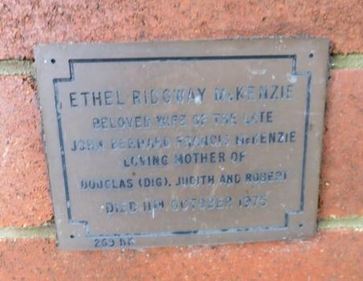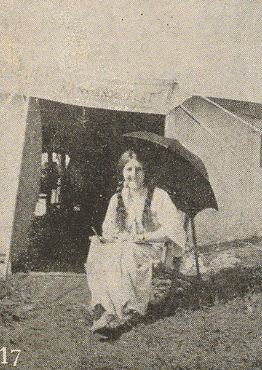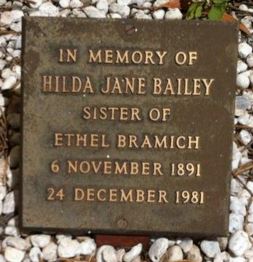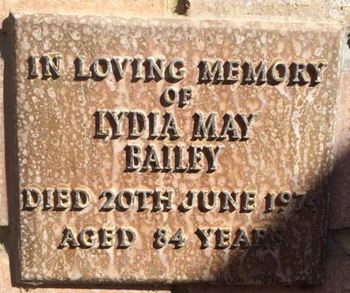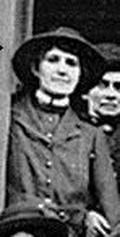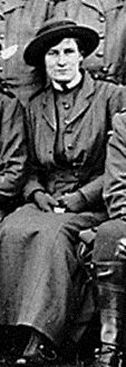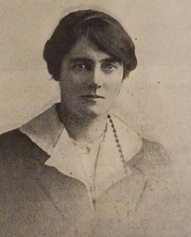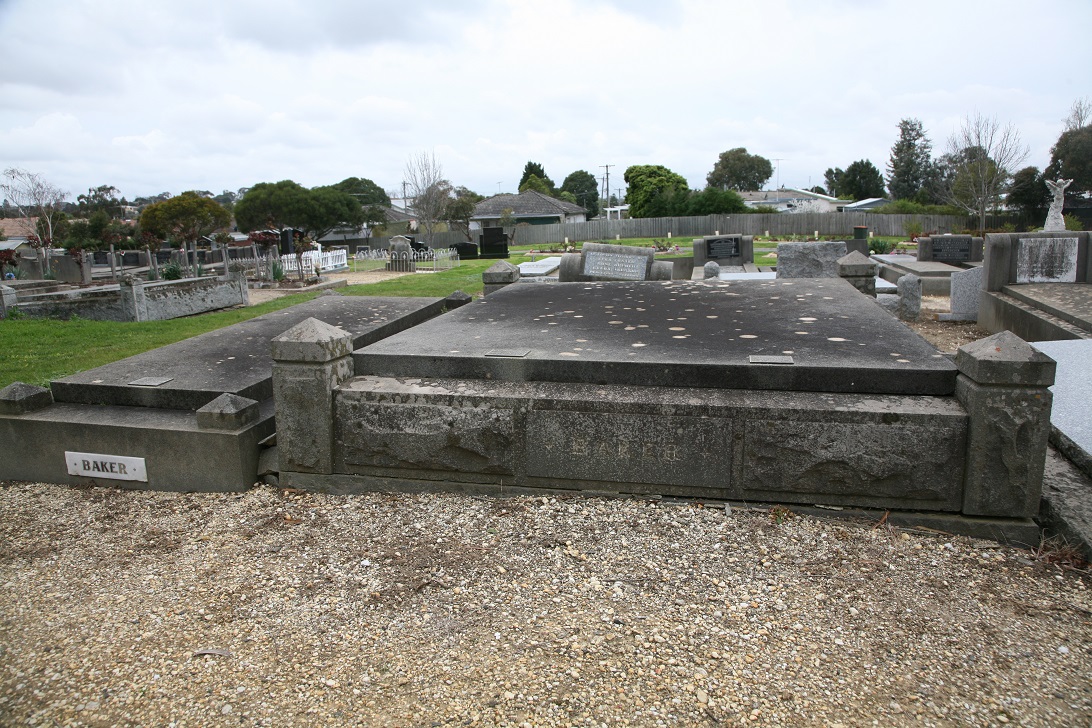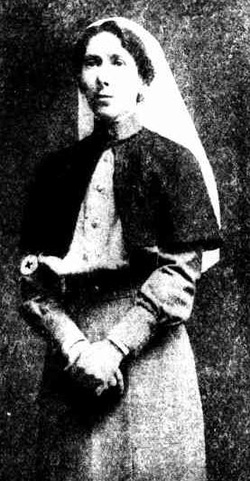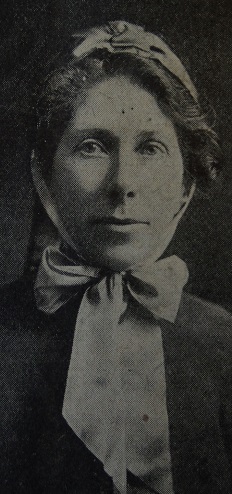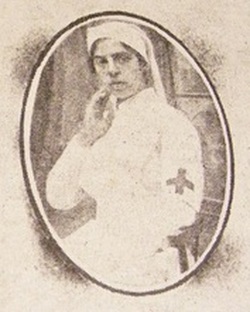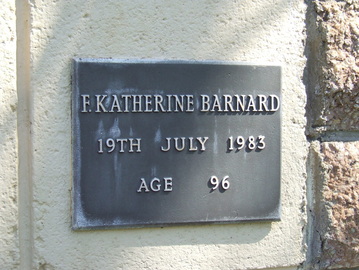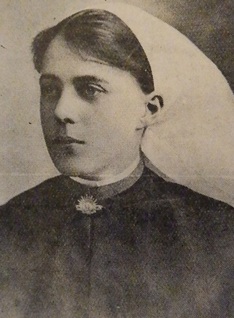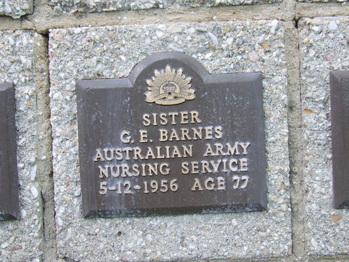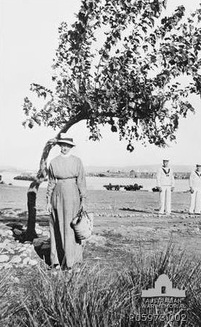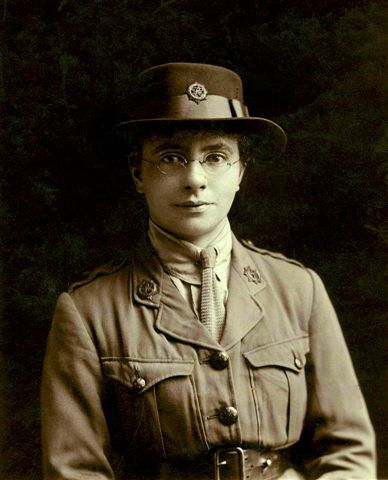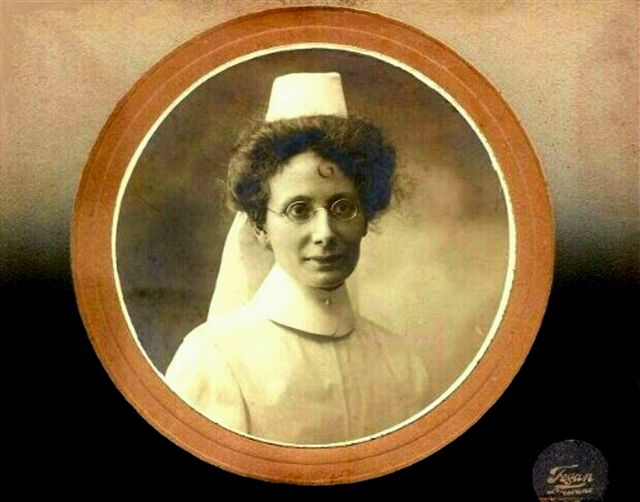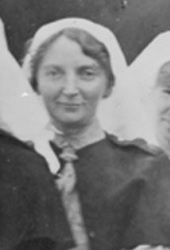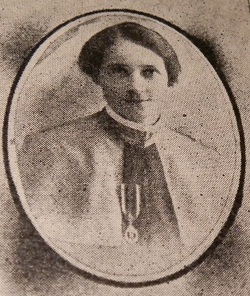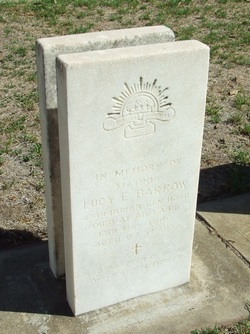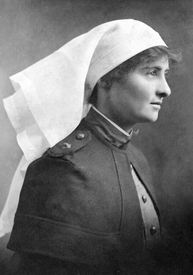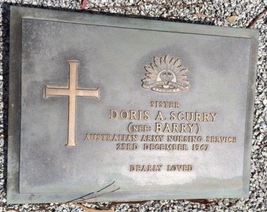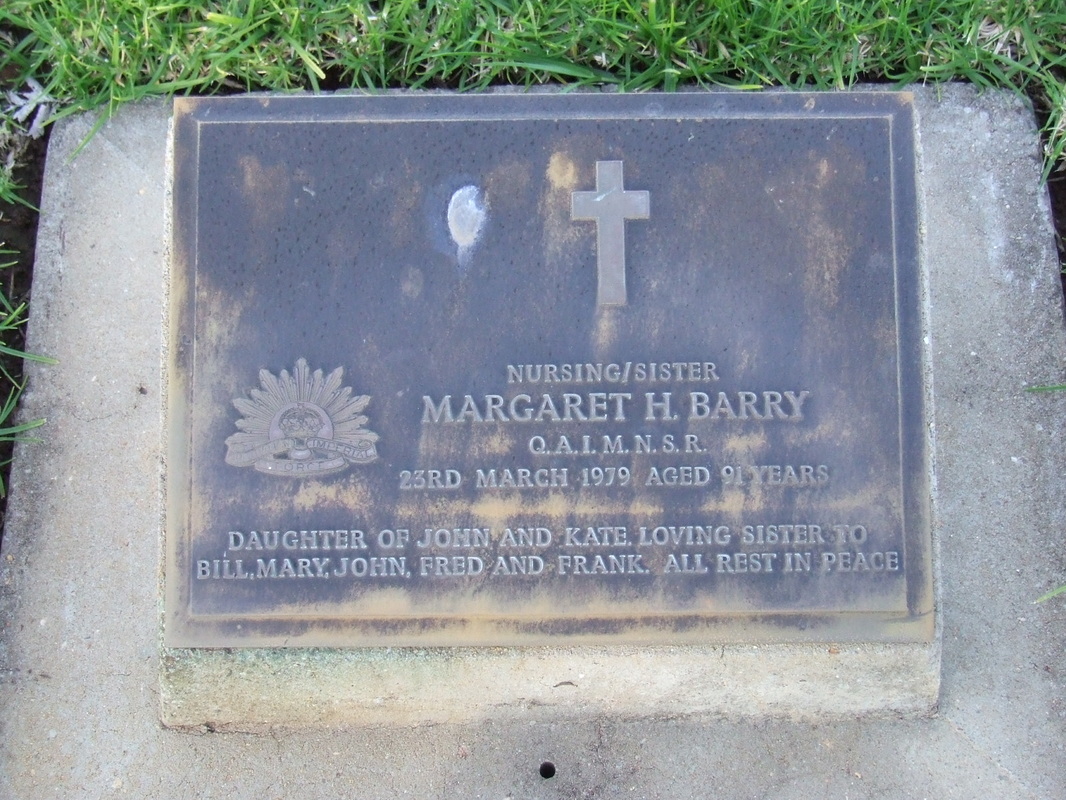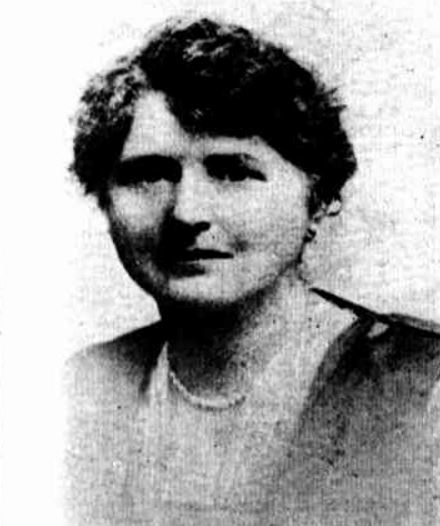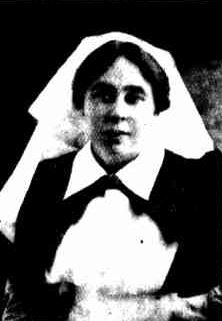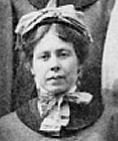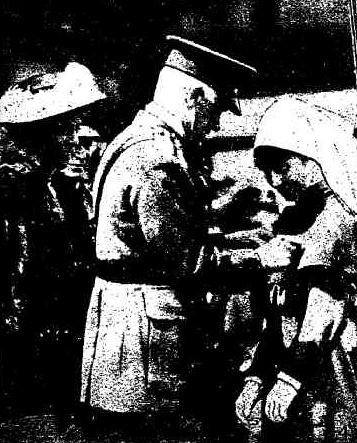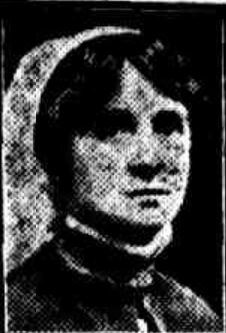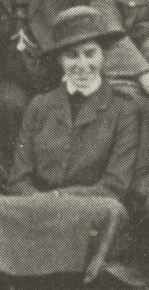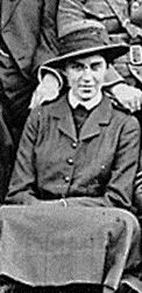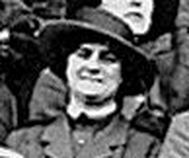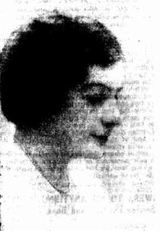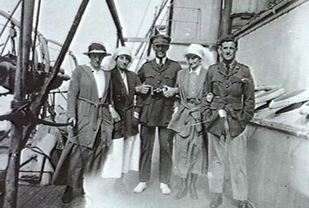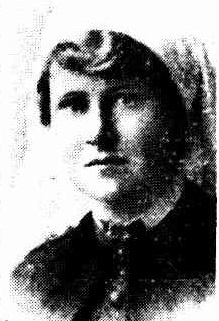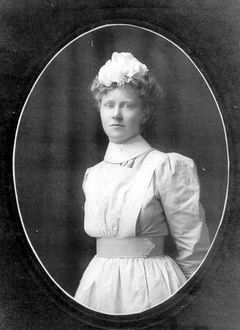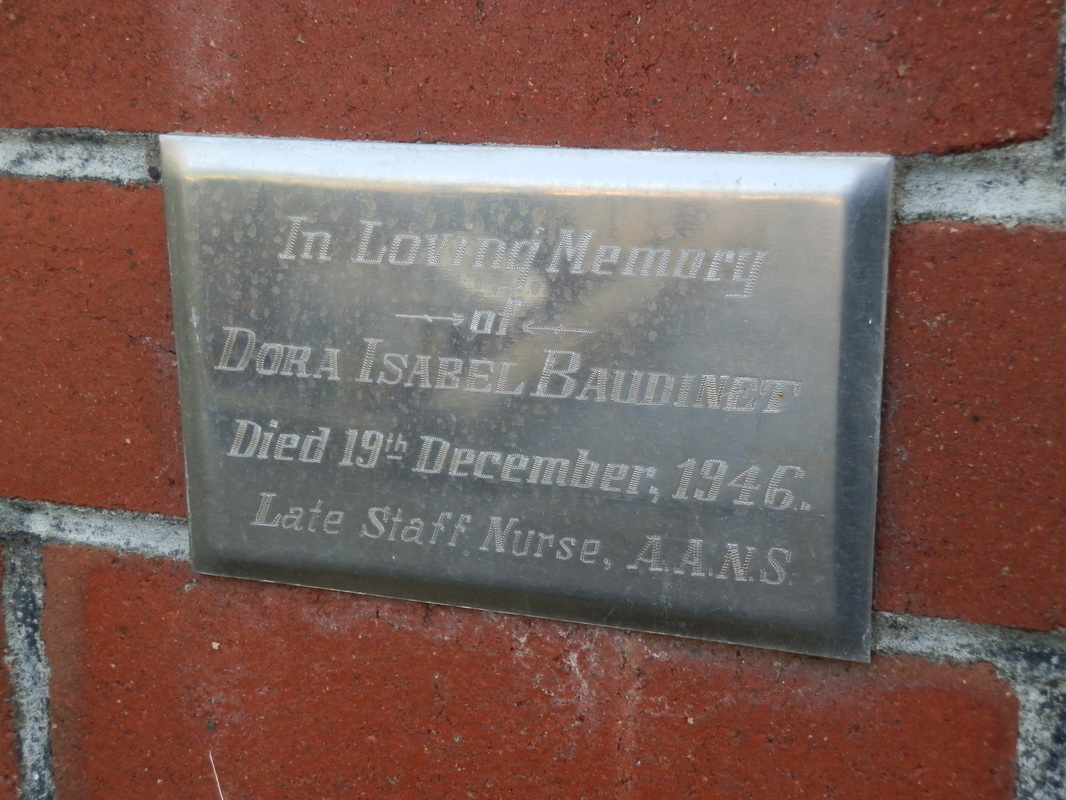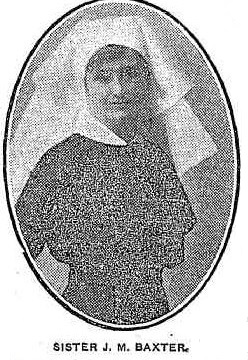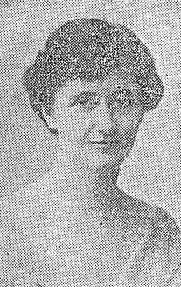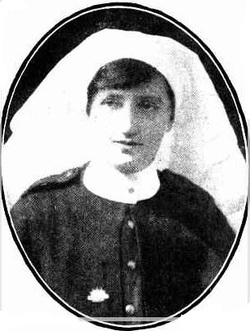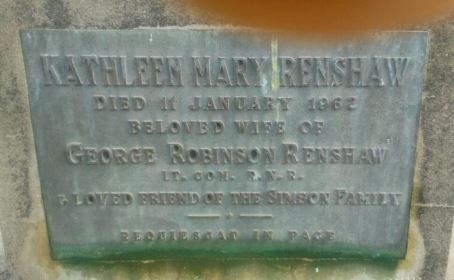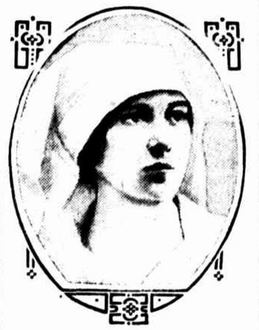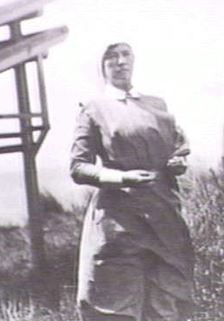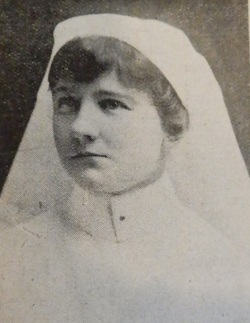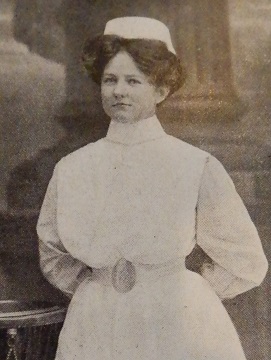BACKHOUSE, Lorna Blachford
Temp. Sister
AANS
No 2 Sea Transport Staff
Queen Alexandra's Imperial Military Nursing Reserve
Born 1881 at Merriwa, NSW
Daughter of Ernest Benjamin and Ida F BACKHOUSE
Of Commercial Bank, Tamworth, NSW
Occupation prior to enlistment Nurse
Appointed to QAIMNSR 04 April 1915
Joined 19 General Hospital Alexandria 15 July 1915
Admitted to Hospital for Suppuration of Thumb (moderate) 08 February 1916
Struck off strength 19 April 1916
Joined for duty 30 April 1916
Joined for duty 08 December 1916 in Cairo Nasrieh Schools Hospital
'Staff Nurse Backhouse commenced duty in this hospital on 8th December 1916. Her work is very good, she is cheerful, kind & was attentive to her patients and is a capable nurse. I consider her suitable for further military services.
'Miss Backhouse has worked here. She is very much liked by her patients and is an efficient worker'
Resigned contract QAIMNSR 04 October 1917
Embarked for Australia via New Zealand at Suez for duty on H T 'Wiltshire' 10 November 1917
Enlisted AANS 19 February 1918
Aged 36 years
Embarked 08 May 1918 from Sydney per 'Osterley'
Served in England
Resigned appointment due to marriage 13 October 1918
Returned to Australia
Married Harry LORD in 1918 in NSW
Resided 98 Gubb Avenue, Oxford Park, Qld.
Died 1974 in Qld.
AANS
No 2 Sea Transport Staff
Queen Alexandra's Imperial Military Nursing Reserve
Born 1881 at Merriwa, NSW
Daughter of Ernest Benjamin and Ida F BACKHOUSE
Of Commercial Bank, Tamworth, NSW
Occupation prior to enlistment Nurse
Appointed to QAIMNSR 04 April 1915
Joined 19 General Hospital Alexandria 15 July 1915
Admitted to Hospital for Suppuration of Thumb (moderate) 08 February 1916
Struck off strength 19 April 1916
Joined for duty 30 April 1916
Joined for duty 08 December 1916 in Cairo Nasrieh Schools Hospital
'Staff Nurse Backhouse commenced duty in this hospital on 8th December 1916. Her work is very good, she is cheerful, kind & was attentive to her patients and is a capable nurse. I consider her suitable for further military services.
'Miss Backhouse has worked here. She is very much liked by her patients and is an efficient worker'
Resigned contract QAIMNSR 04 October 1917
Embarked for Australia via New Zealand at Suez for duty on H T 'Wiltshire' 10 November 1917
Enlisted AANS 19 February 1918
Aged 36 years
Embarked 08 May 1918 from Sydney per 'Osterley'
Served in England
Resigned appointment due to marriage 13 October 1918
Returned to Australia
Married Harry LORD in 1918 in NSW
Resided 98 Gubb Avenue, Oxford Park, Qld.
Died 1974 in Qld.
THREE YEARS ON SERVICE
TAMWORTH NURSE AT THE WAR.
Exciting Experiences.
After an absence of nearly three years at the war fronts, Nurse L. B Backhouse, who is on furlough, is spending a well-earned rest with her mother and father, Mr. and Mrs. E. B. Backhouse, Commercial Bank, Tamworth.
In an interesting chat with a ''DailyObserver" representative, Nurse Backhouse said she left Australian shores in the "Malwa" in March, 1915, and landed in Egypt on 1st May just after the Gallipoli landing. They were really on their way to England, said Nurse Backhouse, but their services were required so badly that orders were given for their disembarkation immediately, and they went to work straight away. Hundreds of wounded came direct from the Peninsula to Cairo, and Nurse Backhouse took up duty at the Heliopolis Palace, No. 1 Australian General Hospital.
Nurse Backhouse was about a month so employed and then went on to the Hospital trains which carried the wounded to the different hospitals as they were landed from the troop and hospital ships in Alexandria harbor. The patients were either taken to Cairo and Port Said, on intervening stations where there were convalescent hospitals established. The trains were beautifully fitted up and very comfortable. When matters became somewhat normal Nurse Backhouse went on to No. 19 General Hospital at Alexandria, and was there when a large number of badly wounded came forward as a result of the Suvla landing. This was a beautiful hospital — a hospital conducted by Germans in peace times, and it was splendidly run. The patients were mostly English boys, but there was a little crowd of Australians, a happy lot of boys, and the "Australian corner" it was generally named. The Australians always seemed to progress well and they were a very contented and happy lot. After 12 months' service at this institution Nurse Backhouse's activities were transferred to a hospital ship. The ship was splendidly fitted up with everything necessary for the care and comfort of the sick and wounded. Cot cases were all in swinging cots.
Nurse Backhouse was enthusiastic over the good work of the Red Cross. She really did not know how they could do without them. The worst time she had was the run across to Salonika in the hospital ship where they took on board a greater number of sick than wounded, suffering from malaria and dysentry. It took about a week to load the ship's complement, and while in the harbor it was so hot they frequently took a run outside to obtain a breath of fresh breeze. These were the boys who appreciated the hospital ship. "The most exciting part of my experience,'' said Nurse Backhouse, "was returning from Salonika to Malta. One evening about 7 o'clock the S.O.S. signal reached us and our boat turned back 70 miles and picked up two crews who were on rafts and in life boats. It was about midnight when we came upon them, and it was a difficult matter to locate them and pick them up. Two boats had been submarined and we just managed to arrive opportunely. As ours was a full ship rough beds had to be made along the decks. Part of the survivors comprised Lascars, and they had all their belongings. They would rather lose their lives than their belongings, and the remainder of the crew were Englishmen, and they did not have a stitch of anything." Nurse Backhouse left the ship for hospital work at Cairo. They had a very heavy time after the Gaza fight in the Desert. "People generally imagine," said Miss Backhouse, "that the soldiers in Egypt have an easy time compared with those on French soil, but such is not the case. The food is not good, they have a particularly hard time in the Desert. Water is scarce and men suffer severely from sun stroke and dysentry. The Australian soldier is a fine stamp of man, who through all his trials and sufferings never grumbles. It is simply marvellous what they went through, and never a murmur."
Nurse Backhouse returned to Australia on a hospital carrier — a troopship roughly fitted up, which carried about 600 wounded. Provision was made for 80 cot cases. The patients did well after a week at sea. They had most enthusiastic welcomes from the Red Cross at Colombo, Fremantle, Melbourne, and Sydney. Fruit, eggs and cigarettes in abundance were supplied and the patients were entertained by motor drives through all the cities. At Ceylon 100 deck chairs were presented to the ship and each soldier received 1lb. of Ceylon tea. Those who could not go ashore at all places of call were visited by Red Cross ladies, who handed round provisions and attended to any little wants. Nurse Backhouse referred to the Turkish wounded and said they were contented and happy in hospital, and always willing to work and anxious to please and what one may term "real sports." In conclusion Nurse Backhouse stated that the Red Cross and Y.M.C.A. rooms were a great boon to the men, and they took full advantage of the comforts and recreations provided. Nurse Backhouse's furlough is coming
to an end, and she is to report for duty at the end of the present month for further service.
Daily Observer Saturday 26 January 1918 page 3
TAMWORTH NURSE AT THE WAR.
Exciting Experiences.
After an absence of nearly three years at the war fronts, Nurse L. B Backhouse, who is on furlough, is spending a well-earned rest with her mother and father, Mr. and Mrs. E. B. Backhouse, Commercial Bank, Tamworth.
In an interesting chat with a ''DailyObserver" representative, Nurse Backhouse said she left Australian shores in the "Malwa" in March, 1915, and landed in Egypt on 1st May just after the Gallipoli landing. They were really on their way to England, said Nurse Backhouse, but their services were required so badly that orders were given for their disembarkation immediately, and they went to work straight away. Hundreds of wounded came direct from the Peninsula to Cairo, and Nurse Backhouse took up duty at the Heliopolis Palace, No. 1 Australian General Hospital.
Nurse Backhouse was about a month so employed and then went on to the Hospital trains which carried the wounded to the different hospitals as they were landed from the troop and hospital ships in Alexandria harbor. The patients were either taken to Cairo and Port Said, on intervening stations where there were convalescent hospitals established. The trains were beautifully fitted up and very comfortable. When matters became somewhat normal Nurse Backhouse went on to No. 19 General Hospital at Alexandria, and was there when a large number of badly wounded came forward as a result of the Suvla landing. This was a beautiful hospital — a hospital conducted by Germans in peace times, and it was splendidly run. The patients were mostly English boys, but there was a little crowd of Australians, a happy lot of boys, and the "Australian corner" it was generally named. The Australians always seemed to progress well and they were a very contented and happy lot. After 12 months' service at this institution Nurse Backhouse's activities were transferred to a hospital ship. The ship was splendidly fitted up with everything necessary for the care and comfort of the sick and wounded. Cot cases were all in swinging cots.
Nurse Backhouse was enthusiastic over the good work of the Red Cross. She really did not know how they could do without them. The worst time she had was the run across to Salonika in the hospital ship where they took on board a greater number of sick than wounded, suffering from malaria and dysentry. It took about a week to load the ship's complement, and while in the harbor it was so hot they frequently took a run outside to obtain a breath of fresh breeze. These were the boys who appreciated the hospital ship. "The most exciting part of my experience,'' said Nurse Backhouse, "was returning from Salonika to Malta. One evening about 7 o'clock the S.O.S. signal reached us and our boat turned back 70 miles and picked up two crews who were on rafts and in life boats. It was about midnight when we came upon them, and it was a difficult matter to locate them and pick them up. Two boats had been submarined and we just managed to arrive opportunely. As ours was a full ship rough beds had to be made along the decks. Part of the survivors comprised Lascars, and they had all their belongings. They would rather lose their lives than their belongings, and the remainder of the crew were Englishmen, and they did not have a stitch of anything." Nurse Backhouse left the ship for hospital work at Cairo. They had a very heavy time after the Gaza fight in the Desert. "People generally imagine," said Miss Backhouse, "that the soldiers in Egypt have an easy time compared with those on French soil, but such is not the case. The food is not good, they have a particularly hard time in the Desert. Water is scarce and men suffer severely from sun stroke and dysentry. The Australian soldier is a fine stamp of man, who through all his trials and sufferings never grumbles. It is simply marvellous what they went through, and never a murmur."
Nurse Backhouse returned to Australia on a hospital carrier — a troopship roughly fitted up, which carried about 600 wounded. Provision was made for 80 cot cases. The patients did well after a week at sea. They had most enthusiastic welcomes from the Red Cross at Colombo, Fremantle, Melbourne, and Sydney. Fruit, eggs and cigarettes in abundance were supplied and the patients were entertained by motor drives through all the cities. At Ceylon 100 deck chairs were presented to the ship and each soldier received 1lb. of Ceylon tea. Those who could not go ashore at all places of call were visited by Red Cross ladies, who handed round provisions and attended to any little wants. Nurse Backhouse referred to the Turkish wounded and said they were contented and happy in hospital, and always willing to work and anxious to please and what one may term "real sports." In conclusion Nurse Backhouse stated that the Red Cross and Y.M.C.A. rooms were a great boon to the men, and they took full advantage of the comforts and recreations provided. Nurse Backhouse's furlough is coming
to an end, and she is to report for duty at the end of the present month for further service.
Daily Observer Saturday 26 January 1918 page 3
BAESJOU, Gwendoline Constance Melville
Born 1888 in Albury, WA
Daughter of Constantin S J and Jessie BAESJOU
Married Corporal Gordon CAPEL-DAVIES 24 April 1915 at St. Leonard's, Bedford, England
Gordon died 30 September 1962 in WA and was buried at Karrakatta Cemetery Crematoium Rose Gardens J 0181
Died 1974 in WA
Nurse Gwen. Baesjou, of Albany, has volunteered for service with the Australian Imperial Expeditionary Force.
Albany Advertiser Wednesday 19 August 1914 page 3
Daughter of Constantin S J and Jessie BAESJOU
Married Corporal Gordon CAPEL-DAVIES 24 April 1915 at St. Leonard's, Bedford, England
Gordon died 30 September 1962 in WA and was buried at Karrakatta Cemetery Crematoium Rose Gardens J 0181
Died 1974 in WA
Nurse Gwen. Baesjou, of Albany, has volunteered for service with the Australian Imperial Expeditionary Force.
Albany Advertiser Wednesday 19 August 1914 page 3
Valedictory.
A number of ladies met at the residence of Mrs. O. W. Berliner on Saturday afternoon to bid farewell to Nurse Gwen. Baesjou, who has volunteered her services at the front. The Mayor, who was present, in his speech eulogised Miss Baesjou's work and congratulated her on her pluck in going so far away from home and friends to give her services where they were most needed. She was, moreover, the first Albany nurse to go, and he regretted there was not time enough to have done something in a bigger way. On behalf of the ladies present, he handed Nurse Baesjou a dainty wrist watch and wished her good luck and bon voyage. Miss Berliner, on behalf of her many girlfriends, gave Miss Baesjou a hand some silver hand mirror. Afternoon tea was handed round and a guessing competition was arranged by Mrs. Berliner for the amusement of her guests, the prize for the highest number of guesses falling to Mrs. Catling. Miss Baesjou left Albany on Sunday, en route for Adelaide, where she will tranship to the s.s. Ballarat, which leaves for London at the beginning of March. She will be accompanied by
her aunt, Miss Moir.
Albany Advertiser Wednesday 24 February 1915 page 2
A number of ladies met at the residence of Mrs. O. W. Berliner on Saturday afternoon to bid farewell to Nurse Gwen. Baesjou, who has volunteered her services at the front. The Mayor, who was present, in his speech eulogised Miss Baesjou's work and congratulated her on her pluck in going so far away from home and friends to give her services where they were most needed. She was, moreover, the first Albany nurse to go, and he regretted there was not time enough to have done something in a bigger way. On behalf of the ladies present, he handed Nurse Baesjou a dainty wrist watch and wished her good luck and bon voyage. Miss Berliner, on behalf of her many girlfriends, gave Miss Baesjou a hand some silver hand mirror. Afternoon tea was handed round and a guessing competition was arranged by Mrs. Berliner for the amusement of her guests, the prize for the highest number of guesses falling to Mrs. Catling. Miss Baesjou left Albany on Sunday, en route for Adelaide, where she will tranship to the s.s. Ballarat, which leaves for London at the beginning of March. She will be accompanied by
her aunt, Miss Moir.
Albany Advertiser Wednesday 24 February 1915 page 2
Mr. and Mrs. C. S. J. Baesjou, Vancouver street, have received a letter from their daughter, Nurse Gwen Baesjou, who has been engaged in England and abroad in war nursing work, stating that she has been recommended for the Royal Red Cross. A somewhat belated cable has also been received from Corporal-Captain Davies, of the Royal Field Artillery, who went to France with Kitchener's First Hundred Thousand, stating that he has been demobilised, and that his marriage with Nurse Baesjou would take place on April 29.
Albany Advertiser Saturday 10 May 1919 page 3
Albany Advertiser Saturday 10 May 1919 page 3
CAPEL-DAVIES-BAESJOU - On the 28th April, at St. Leonard's, Bedford, England, Gordon (R.A.F.), third son of the late Arthur Capel-Davies and Mrs. Capel-Davies, of 52 Brunswick-square, Hove, Brighton, to Sister Gwendoline Constance Melville Baesjou, elder daughter of Mr. and Mrs. C. S. J. Baesjou, Albany, W.A. 515
Albany Advertiser Saturday 07 June 1919 page 2
Albany Advertiser Saturday 07 June 1919 page 2
Mrs. Capel Davies, nee Nurse Gwen Baesjou, together, with her husband, Corporal Capel-Davies. returned home by the transport Bremen, which arrived at Fremantle on Tuesday. Nurse Baesjou offered for service and was accepted in February, 1915. On arrival in England she joined the staff of the Bedford Military Hospital, where she carried out her good work until April of this year, when she left to get married. She is the daughter of Mr. and Mrs. C. S. J. Baesjou, of Albany.
The Daily News Perth Saturday 19 July 1919 page 5
The Daily News Perth Saturday 19 July 1919 page 5
Sister Capel-Davies, who had gone from Albany at the beginning of the war as Nurse Baesjou. Another feature of the gathering was that it was the largest yet held, an economic proof that the war was really over and the larger numbers were returning than heretofore. There were present many boys who had gone away in the early stages of the conflict, and although they had seen most of the fighting still was worthy of notice, and a pleasure withal, that they were home again apparently sound in wind and limb. Of Nurse Capel-Davies he felt that no words could express the great delight he felt to see her among them again and he was sure those feelings would be echoed of everybody in Albany.
Albany Advertiser Saturday 02 August 1919 page 3
Albany Advertiser Saturday 02 August 1919 page 3
Mr. and Mrs. Davis have come to settle in Kalgoorlie, and have taken a house in Collins-street . You will remember Mrs. Davis as Miss Gwen Baesjou. who was for some time nursing in the Government Hospital in Kalgoorlie. Mrs. Davis and her husband have both been on active service during the great war.
Kalgoorlie Miner Friday 10 June 1921 page 3
Kalgoorlie Miner Friday 10 June 1921 page 3
BAILEY, Eileen Brooke
Nurse
British Red Cross
Born 1888 in Albany, WA
Daughter of George Herbert BAILEY and Isabel Agnes nee GIBSON
Embarked Melbourne 27 September 1916 on the 'Osterley', age 28 as one of 30 Red Cross VADs requested by the chairman of the joint war committee of the British Red Cross Society and the Order of St John to serve as probationers in military hospitals in England.
Served 20 November 1916 - 20 June 1918 University War Hospital, Southampton; 31 July 1918 - 20 October1918 War Hospital, Reading.
Received 1 Scarlet Efficiency Stripe 20 December 1917
Returned to Australia 1919
Died 1958 in Hobart, Tas
Aged 69 years
Cremated 12 May 1958 at Cornelian Bay Cemetery - no burial record
Courtesy of Frev
The three women orderlies for assisting in military nursing that were to be appointed from Tasmania have been selected. They are Miss Eileen Bailey and Miss Helen Fisher, from Hobart, who have both been trained in the General Hospital, and Miss Douglas, from Launceston. The names submitted were sent to the Governor from registered societies and by him sent on to H.E. Lady Helen Munro Ferguson, as the head of the Australian
branch of the British Red Cross Society, and by her the final decision was made. The orderlies will probably leave Melbourne on September 27
Tasmanian Mail 31 August 1916 page 9 col 1
A farewell afternoon tea was given by the president (Mrs. Sprott) Voluntary Aid Committee to Aids Bailey and Fisher prior to their sailing for England, where they take up their duties in a military hospital as probationary nurses, under the Red Cross.
Tasmanian Mail 28 September 1916 page 9 col 3
On Tuesday, January 21, an 'at home' was given by the commandant and officers of the First V.A.D. at the residence of the Commandant (Mrs. W W Giblin, Macquarie Street) to welcome home Miss Eileen Bailey, who has just returned from England, where she has been engaged with nursing in military hospitals. Miss Bailey was a voluntary aid from the First Detachment, who went to England nearly three years ago, under the British Red Cross, to do war work. She has had a very varied and wide experience, but is looking remarkably well, not withstanding her hard work. She is very glad to be home again. The hostess (Mrs. Giblin) received the guests in the drawing room, which was beautifully decorated with crimson carnations. A dainty supper was served in the dining room, the table being very prettily arranged with large white marguerites.
Tasmanian Mail January 23 page 3 col 3
British Red Cross
Born 1888 in Albany, WA
Daughter of George Herbert BAILEY and Isabel Agnes nee GIBSON
Embarked Melbourne 27 September 1916 on the 'Osterley', age 28 as one of 30 Red Cross VADs requested by the chairman of the joint war committee of the British Red Cross Society and the Order of St John to serve as probationers in military hospitals in England.
Served 20 November 1916 - 20 June 1918 University War Hospital, Southampton; 31 July 1918 - 20 October1918 War Hospital, Reading.
Received 1 Scarlet Efficiency Stripe 20 December 1917
Returned to Australia 1919
Died 1958 in Hobart, Tas
Aged 69 years
Cremated 12 May 1958 at Cornelian Bay Cemetery - no burial record
Courtesy of Frev
The three women orderlies for assisting in military nursing that were to be appointed from Tasmania have been selected. They are Miss Eileen Bailey and Miss Helen Fisher, from Hobart, who have both been trained in the General Hospital, and Miss Douglas, from Launceston. The names submitted were sent to the Governor from registered societies and by him sent on to H.E. Lady Helen Munro Ferguson, as the head of the Australian
branch of the British Red Cross Society, and by her the final decision was made. The orderlies will probably leave Melbourne on September 27
Tasmanian Mail 31 August 1916 page 9 col 1
A farewell afternoon tea was given by the president (Mrs. Sprott) Voluntary Aid Committee to Aids Bailey and Fisher prior to their sailing for England, where they take up their duties in a military hospital as probationary nurses, under the Red Cross.
Tasmanian Mail 28 September 1916 page 9 col 3
On Tuesday, January 21, an 'at home' was given by the commandant and officers of the First V.A.D. at the residence of the Commandant (Mrs. W W Giblin, Macquarie Street) to welcome home Miss Eileen Bailey, who has just returned from England, where she has been engaged with nursing in military hospitals. Miss Bailey was a voluntary aid from the First Detachment, who went to England nearly three years ago, under the British Red Cross, to do war work. She has had a very varied and wide experience, but is looking remarkably well, not withstanding her hard work. She is very glad to be home again. The hostess (Mrs. Giblin) received the guests in the drawing room, which was beautifully decorated with crimson carnations. A dainty supper was served in the dining room, the table being very prettily arranged with large white marguerites.
Tasmanian Mail January 23 page 3 col 3
BAILEY, Ethel RidgwayStaff Nurse
AANS No 7 Base Hospital 3rd Australian Auxiliary Hospital 1st Australian General Hospital Born 1889 at Sydney, NSW Daughter of Charles and Adelaide Mary BAILEY Of Cable Station, Southport, Qld. Occupation prior to enlistment Nurse Aged 26 years Enlisted 03 June 1915 Embarked 16 June 1915 from Sydney per 'Karoola' Served in Egypt, London and France Resigned as consequence of marriage in UK 14 December 1918 Married 14 December 1918 in England to John Bernard Francis McKenzie who was a Captain in the Australian Medical Corps WW1. Died 11 October 1975 at Randwick, NSW Formerly of Newport Beach and Newcastle, NSW Buried Northern Suburbs Memorial Gardens East Terrace, Area 2 Wall 13 |
BAILEY, Hilda Jane
|
Staff Nurse
AANS Born 06 Novmeber 1891 in Launceston, Tasmania Daughter of Edward Lennox BAILEY and Caroline Rosevear nee VINCENT Of Melbourne Street, Launceston, Tasmania Occupation prior to enlistment Trained Nurse at General Hospital, Launceston Enlisted 18 May 1917 at Launceston, Tasmania Aged 25 years Embarked 12 June 1917 from Melbourne per 'Mooltan' Served in Macedonia Contracted Debility Returned to Australia per 'Kanowna' 01 September 1918 Discharged as medically unfit 13 December 1918 Did not marry. Died 24 December 1981 in Queensland. Gravestone for a Hilda Jane Bailey 1891-1981 at St Marks Anglican Church, Deloraine, Tasmania Tasmania Weekly Courier 07 March 1918 Insert 5 Ceylon Red Cross Job For Adelaide Nurse
Sister H. J. Bailey, a Tasmanian nurse, who served in the last war,and who has made her home in Adelaide for the last 16 years, has been appointed senior superintendent of the Red Cross convalescent home at Ottery, Ceylon. She will leave for Melbourne tonight. This will be Sister Bailey's tenth visit to Ceylon, and she is already familiar with the district in which she will work, tor she was on the staff of the Halton Nursing Home, about eight miles from the Red Cross home, for three years Sister Bailey said yesterday that the home, which belonged to a planter, and had been lent to Red Cross, was in a delightful position in the hills, and she expected to meet many Australian servicemen there. Sister Bailey returned from Ceylon in 1942, and for 15 months has been engaged in confidential military duties in Adelaide. The Advertiser Wednesday 31 January 1945 page 3 |
BAILEY, Lydia MaySister
AANS Born 04 September 1891 at Perth, WA Daughter of Mrs. G BAILEY Of Government Savings Bank, Northam Enlisted 01 September 1916 at Frematle, WA Occupation prior to enlistment Nurse at Children's Hospital, Perth Joined No 8 General Hospital, Fremantle and sailed 29 January 1917 Served in London and France Returned to Australia per 'Wandilla' 09 May 1919 Discharged 17 November 1919 Died at Subiaco, Perth 20 June 1974 Aged 84 years Cremated and interred at Karrakatta Cemetery Lawn 5 W6 0100 |
BAILEY, Trissie
Staff Nurse
AANS
Born 06 December 1892 at Tumbarumba, NSW
Daughter of William Dixon BAILEY and Ellen nee VENABLES
Of Brackendale, Pomona, N C Line, Qld.
Occupation prior to enlistment Nurse
Enlisted 06 November 1917
Aged 24 years
Embarked 16 November 1917 from Sydney per 'Canberra'
Served in Bombay and Gharial, India
Returned to Australia 19 November 1919 per 'Montoro'
Married Robert Gavin Ralston after 1938
He died in 19th December 1947.
Resided Villiers St., Lota and late of Toowoomba Qld.
Trissie remarried to Clarence Walter Weis.
Trissie died 31 July 1991 in NSW
Aged 98 years
Late of Dunedoo, NSW
AANS
Born 06 December 1892 at Tumbarumba, NSW
Daughter of William Dixon BAILEY and Ellen nee VENABLES
Of Brackendale, Pomona, N C Line, Qld.
Occupation prior to enlistment Nurse
Enlisted 06 November 1917
Aged 24 years
Embarked 16 November 1917 from Sydney per 'Canberra'
Served in Bombay and Gharial, India
Returned to Australia 19 November 1919 per 'Montoro'
Married Robert Gavin Ralston after 1938
He died in 19th December 1947.
Resided Villiers St., Lota and late of Toowoomba Qld.
Trissie remarried to Clarence Walter Weis.
Trissie died 31 July 1991 in NSW
Aged 98 years
Late of Dunedoo, NSW
BAILLIE, Lavinia Marama
Staff Nurse
AANS
No 2 General Hospital
Born 16 July 1874 in Levira, Fiji
Daughter of Allan BAILLIE and Mary Ann nee TEBBUTT
Her father drowned in Fiji in 1877
Sister of Emma RUSSELL
Of 'Kirkaldy' Cavendish Street, Stanmore, Sydney, NSW
Occupation prior to enlistment Nurse at Frematle Public Hospital
Aged 33 years
Enlisted 12 June 1915 at Fremantle, WA per 'Orsova'
Embarked 22 July 1915
Served in Egypt
Returned to Australia 09 May 1916 per 'Demosthenes'
Discharged as medically unfit 29 July 1916
She was a nurse for the Baby Health Centres in New South Wales and retired in 1939.
She did not marry
Died 4 November 1952 in Lindfield, New South Wales.
AANS
No 2 General Hospital
Born 16 July 1874 in Levira, Fiji
Daughter of Allan BAILLIE and Mary Ann nee TEBBUTT
Her father drowned in Fiji in 1877
Sister of Emma RUSSELL
Of 'Kirkaldy' Cavendish Street, Stanmore, Sydney, NSW
Occupation prior to enlistment Nurse at Frematle Public Hospital
Aged 33 years
Enlisted 12 June 1915 at Fremantle, WA per 'Orsova'
Embarked 22 July 1915
Served in Egypt
Returned to Australia 09 May 1916 per 'Demosthenes'
Discharged as medically unfit 29 July 1916
She was a nurse for the Baby Health Centres in New South Wales and retired in 1939.
She did not marry
Died 4 November 1952 in Lindfield, New South Wales.
BAIN, Harriet Mary Hazel
Staff Nurse
AANS
Born 31 January 1891 at Maryborough, Vic.
Daughter of John BAIN (Stationmaster) and Winifred Louisa nee JONES
Of 'Grantham' Moorhouse Street, West Richmond, Vic.
Trained at Austin Hospital (3 years)
Occupation prior to enlistment Nurse at Austin Hospital
Aged 27 years
Enlisted 28 June 1918
Embarked 16 October 1918 from Sydney per 'Malta'
Disembarked 14 November 1918 at Bombay, India
Served in 34th Welsh General Hospital, Deolali, India
Resigned on account of marriage 09 March 1919
Married 09 March 1919 in Deolali, India to Alan Eugene Cecil McGAVIN, MBE (Captain, Indian Army Res)
They lived in India for some time. Her husband was Administrator and Judge of the Political Department of the Government of India.
Their son Alan Stewart Denzil McGavin was born in India 1920. He was a Captain in the Australian Army and was killed in action in New Guinea aged 22 years.
Another son, Peter Edwin McGavin was born 25 March 1922 in Hazaribagh, India
Hazel & Alan travelled from Bombay, India to the UK on the California, arriving Liverpool 16 April 1935 – and returned to India on the Britannia, departing Liverpool 23 November 1935
Sons Alan & Peter were educated in England at St Edmund’s College, Ware, Herts – they departed the UK 23 July 1937 on the Mooltan, and joining their mother in Bombay, continued on with her to Australia on the Mongolia, passing through Fremantle, WA on the 21 September 1937 for Melbourne
Alan (Snr) sailed from Bombay on the Narkunda, which passed through Fremantle, WA 16 November 1937, before disembarking him in Melbourne
On their return to Australia the family first stayed with Hazel’s parents at 15 Main St, Blackburn, Vic
Living 17 Jenning St, Sandringham, Vic 1938
Living Black Rock (near Cheltenham), Vic 1942, 1948
Hazel died 15 March 1973 Seaford, Vic, age 81 and was interred in the New Cheltenham Cemetery with her husband, Alan
"Here where my Father lies - may she find eternal peace in God - ever remembered by her loving son Peter"
Courtesy of Heather Ford
AANS
Born 31 January 1891 at Maryborough, Vic.
Daughter of John BAIN (Stationmaster) and Winifred Louisa nee JONES
Of 'Grantham' Moorhouse Street, West Richmond, Vic.
Trained at Austin Hospital (3 years)
Occupation prior to enlistment Nurse at Austin Hospital
Aged 27 years
Enlisted 28 June 1918
Embarked 16 October 1918 from Sydney per 'Malta'
Disembarked 14 November 1918 at Bombay, India
Served in 34th Welsh General Hospital, Deolali, India
Resigned on account of marriage 09 March 1919
Married 09 March 1919 in Deolali, India to Alan Eugene Cecil McGAVIN, MBE (Captain, Indian Army Res)
They lived in India for some time. Her husband was Administrator and Judge of the Political Department of the Government of India.
Their son Alan Stewart Denzil McGavin was born in India 1920. He was a Captain in the Australian Army and was killed in action in New Guinea aged 22 years.
Another son, Peter Edwin McGavin was born 25 March 1922 in Hazaribagh, India
Hazel & Alan travelled from Bombay, India to the UK on the California, arriving Liverpool 16 April 1935 – and returned to India on the Britannia, departing Liverpool 23 November 1935
Sons Alan & Peter were educated in England at St Edmund’s College, Ware, Herts – they departed the UK 23 July 1937 on the Mooltan, and joining their mother in Bombay, continued on with her to Australia on the Mongolia, passing through Fremantle, WA on the 21 September 1937 for Melbourne
Alan (Snr) sailed from Bombay on the Narkunda, which passed through Fremantle, WA 16 November 1937, before disembarking him in Melbourne
On their return to Australia the family first stayed with Hazel’s parents at 15 Main St, Blackburn, Vic
Living 17 Jenning St, Sandringham, Vic 1938
Living Black Rock (near Cheltenham), Vic 1942, 1948
Hazel died 15 March 1973 Seaford, Vic, age 81 and was interred in the New Cheltenham Cemetery with her husband, Alan
"Here where my Father lies - may she find eternal peace in God - ever remembered by her loving son Peter"
Courtesy of Heather Ford
BAIRD, EileenStaff Nurse
AANS Born Eileen Baird McLAUGHLIN in 1889 in Goulburn, NSW Daughter of Henry McLAUGHLIN and Ellen nee BAIRD Of 146 Phillip Street, Sydney, NSW Occupation prior to enlistment Trained Nurse Enlisted 01 December 1916 Embarked 09 June 1917 from Sydney per 'Mooltan' Aged 27 years Served in Egypt Returned to Australia per 'Ulysses' 15 March 1919 Discharged as medically unfit 12 July 1919 Awarded the Medal of Military Merit 4th Class by H M King of the Hellenes. Extract from List 161 approved by the GOG in E British Army of the Black Sea 27 May 1919 Most records show she used McLaughlin. She went to USA and became a naturalized citizen in New York. *** there is a record of an Eileen B McLaughlin death in New York on 2 December 1987. Gives her date of birth as 22 March 1889.*** |
BAKER, AdeleStaff Nurse
AANS 1st Australian General Hospital Born 1891 in Penrith, Sydney, NSW Daughter of Alfred Edward BAKER and Sophia nee AHSBURY Of Commercial Bank, Penrith Occupation prior to enlistment Trained Nurse Enlisted 20 April 1917 Aged 25 years Embarked 09 June 1917 from Sydney per 'Mooltan' Served in Egypt Returned to Australia per 'Orsova' 06 September 1919 with Malaria Discharged as medically unfit 29 January 1920 Adele married Dr Frederick Donald Herbert Blois Lawton but he was known as Blois Lawton. He was a medical officer (Major) in the Australian Army. He was made an Officer of the British Empire in 1918. He died 16 July 1961. Adele died in Melbourne 1966 (Mary Adele) cremated Springvale Botanical Cemetery 03 March 1966 and remains collected |
BAKER, Dorothy Emily
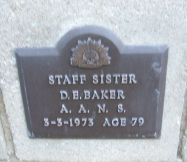
Staff Nurse
AANS
Born 23 January 1894 at Dublin, SA
Daughter of Frederick George BAKER and Eliza Alice nee KELLY
Of Riverton, SA
Occupation prior to enlistment Nurse
Enlisted 13 November 1917 at Keswick, SA
Aged 23 years
Served in Bombay and Gharial, India
Returned to Australia per 'Dilwarra' to Singapore then 'Charon' to Frematle arriving 21 December 1919
Did not marry
Died 03 March 1973
Aged 79 years
Buried Centennial Park Cemetery RSL Walls
AANS
Born 23 January 1894 at Dublin, SA
Daughter of Frederick George BAKER and Eliza Alice nee KELLY
Of Riverton, SA
Occupation prior to enlistment Nurse
Enlisted 13 November 1917 at Keswick, SA
Aged 23 years
Served in Bombay and Gharial, India
Returned to Australia per 'Dilwarra' to Singapore then 'Charon' to Frematle arriving 21 December 1919
Did not marry
Died 03 March 1973
Aged 79 years
Buried Centennial Park Cemetery RSL Walls
BAKER, Maud Isabel
|
Temp. Head Sister
AANS 1st Australian General Hospital Born 1887 in Perth, WA Daughter of Henry BAKER and Mary Ann nee SUTCLIFFE Of 'Tranby Park' Peninsula, Maylands, WA Occupation prior to enlistment Nurse at Perth Public Hospital and Women's Hospital Enlisted 28 November 1914 Embarked 05 December 1914 Aged 27 years Served in France Resigned appointment in England 24th September 1917 Married 24 September 1917 to Dr. Roy William Chambers Returned to Australia Married - now Mrs. M J CHAMBERS Of 'Heatherlugh' Campbell Street, Sandingham, Vic. Died 1961 in Vic. Awarded OBE (Civil Division) 1956. Listed in The Argus (Melbourne) Monday 2nd January 1956 Page 11 "MRS. MAUD ISABEL CHAMBERS (Toorak): President, Returned Nurses' Club, Melbourne; President Royal Melbourne Hospital auxiliary. also listed in the Commonwealth of Australia Gazette, Thursday 12th January 1956 [Issue No.2] Page 75 under the sub heading "To be an Officer of the Civil Division of the said Most Excellent Order" Photograph Table Talk Thursday 10 December 1914 page 22 Punch Thursday 10 December 1914 page 18 |
|
Her husband was Roy William Chambers a Lieutenant Colonel in WW1. Mentioned in Despatches and was awarded DSO. He was born in Sandringham Victoria 1 January 1890 the son of William Chambers and Mary Ann Callaghan. He was a medical practitioner, gynaecologist and obstetrician. He was considered in his time to be one of the leading Gynaecologist in Australia. He died 28 March 1944 in Melbourne.
|
BAKER, Muriel MaryStaff Nurse
AANS Born 1892 Colac, Vic. Daughter of Joseph BAKER and Annie nee COLLINS Of McDonald Street, Belmont, Geelong, Vic. Occupation prior to enlistment Nurse at Geelong Hospital Member of Royal Victoria Trained Nursing Association Aged 26 years Enlisted 26 May 1917 Embarked 12 June 1917 from Melbourne per 'Mooltan' Served in Salonika Returned to Australia per 'Leicestershire' 22 July 1919 Discharged as medically unfit 11 July 1919 Died 02 October 1974 at Geelong, Vic. Resided Geelong, Vic. Buried Highton (Barrabool Hills) Cemetery HGH MET 01 807 128 Photographs courtesy of Cheryl Baulch |
BALL, Irene Laura
Staff Nurse
AANS
Born 20 July 1894 at Smithfield, SA
Daughter of Charles BALL and Eliza Jane nee JENKINS
C/- Post Office, Port Adelaide, SA
Aged 22 years
Trained at Adelaide Childrens Hospital
Did not proceed overseas
Reported for duty at No 15 AGH 23 October 1917
Transferred to No 7 AGH
Transferred to Angas College 18 February 1919
Sent to Quarantine Dept. for duty at Port Augusta 26 April 1919
Returned sick convalescent from Influenza 20 June 1919
Demobilized 24 July 1919
Married William Smith in 1921
Died 19 September 1980
AANS
Born 20 July 1894 at Smithfield, SA
Daughter of Charles BALL and Eliza Jane nee JENKINS
C/- Post Office, Port Adelaide, SA
Aged 22 years
Trained at Adelaide Childrens Hospital
Did not proceed overseas
Reported for duty at No 15 AGH 23 October 1917
Transferred to No 7 AGH
Transferred to Angas College 18 February 1919
Sent to Quarantine Dept. for duty at Port Augusta 26 April 1919
Returned sick convalescent from Influenza 20 June 1919
Demobilized 24 July 1919
Married William Smith in 1921
Died 19 September 1980
BALL, Lousia Sarah Augusta
|
Sister
AANS No 3 Australian General Hospital Born 1872 at Kew, Victoria Daughter of William BALL and Selina nee OWEN Sister of E J BALL Of 12 McKinley Avenue, Malvern, Vic. Occupation prior to enlistment Matron at Ararat Hospital Enlisted 10 May 1915 Embarked 18 May 1915 from Melbourne per 'Mooltan' Aged 43 years Served in Lemnos Island, Abassai, Egypt and Kitchener Hospital in Brighton England. Returned to Australia 13 November 1917 per 'Ulysses' Discharged 20 February 1918 Did not marry Died 1960 in Vic. |
BALLARD, Rosalind Eva
Sister
AANS
Born at Footscray, Melbourne, Vic
Daughter of G E BALLARD
Of Whittlesea Post Office, Victoria
Occupation prior to enlistment Army Nurse
Enlisted 11 December 1916
Embarked 26 December 1916 from Melbourne per 'Mooltan'
Aged 29 years
Served in Bombay, India
Returned to Australia 10 November 1919 per 'Mahana'
Appointment terminated 28 February 1920
Did not marry
Died 08 February 1956 at her home Church Street, Whittlesea.
Cremated 10 February 1956 at Springvale Botanical Cemetery and cremated remains scattered within the cemetery
Matron For War Nurses' Hostel
Sister Rosalind E. Ballard, a returned army nurse, has been appointed matron of the Lady Dugan Red Cross Hostel and Convalescent Home for War Nurses, for which Mrs. Ernest Poolman has lent her home, Domain rd., South Yarra.
Matron Ballard is thrilled at the thought of looking after the army sisters who will use the hostel, as she knows herself from experience during the 1914-18 war how very necessary mid helpful such a hostel can be to an army nurse.
The new matron Is well known in many ports of Victoria. Her home is in Whittlesea. She has been associated with hospitals at Bairnsdale, Mildura, and Wangaratta. She trained at the Bairnsdale District Hospital and the Women's Hospital, Melbourne, and loft Australia with a group of army nurses who left for India in the Mooltan in 1916 with Matron G. Davis, now matron of Hamilton Russell House, as the matron in charge. For l8 months she was in India, and served at military hospitals in Bombay, Secunderabad, and Bangalore, and then served on the hospital ship Egypt, running between India and Egypt. Later she was billeted in Egypt for a time before being sent to England, where she served in various military hospitals until 1920, when she returned to Australia.
For three years after her return she was sister and noting matron at the base hospital, Mildura, and then after a few months as theatre sister at the Wangaratta Hospital returned to Mildura to open her own private hospital, which she ran for about 10 years. Later she was on the staff at Epworth Hospital, and since the outbreak of the present war has been sister in charge of the Tatura camp dressing station and the Seymour camp dressing station.
Now she is looking forward keenly to the change over from attending to soldier patients to caring for the nurses who will use the Lady Dugan Hostel, which will have accommodation for 10 convalescent war nurses and 20 war nurses who may be passing through Melbourne in the course of their duties.
The Argus Saturday 01 February 1941 page 9
AANS
Born at Footscray, Melbourne, Vic
Daughter of G E BALLARD
Of Whittlesea Post Office, Victoria
Occupation prior to enlistment Army Nurse
Enlisted 11 December 1916
Embarked 26 December 1916 from Melbourne per 'Mooltan'
Aged 29 years
Served in Bombay, India
Returned to Australia 10 November 1919 per 'Mahana'
Appointment terminated 28 February 1920
Did not marry
Died 08 February 1956 at her home Church Street, Whittlesea.
Cremated 10 February 1956 at Springvale Botanical Cemetery and cremated remains scattered within the cemetery
Matron For War Nurses' Hostel
Sister Rosalind E. Ballard, a returned army nurse, has been appointed matron of the Lady Dugan Red Cross Hostel and Convalescent Home for War Nurses, for which Mrs. Ernest Poolman has lent her home, Domain rd., South Yarra.
Matron Ballard is thrilled at the thought of looking after the army sisters who will use the hostel, as she knows herself from experience during the 1914-18 war how very necessary mid helpful such a hostel can be to an army nurse.
The new matron Is well known in many ports of Victoria. Her home is in Whittlesea. She has been associated with hospitals at Bairnsdale, Mildura, and Wangaratta. She trained at the Bairnsdale District Hospital and the Women's Hospital, Melbourne, and loft Australia with a group of army nurses who left for India in the Mooltan in 1916 with Matron G. Davis, now matron of Hamilton Russell House, as the matron in charge. For l8 months she was in India, and served at military hospitals in Bombay, Secunderabad, and Bangalore, and then served on the hospital ship Egypt, running between India and Egypt. Later she was billeted in Egypt for a time before being sent to England, where she served in various military hospitals until 1920, when she returned to Australia.
For three years after her return she was sister and noting matron at the base hospital, Mildura, and then after a few months as theatre sister at the Wangaratta Hospital returned to Mildura to open her own private hospital, which she ran for about 10 years. Later she was on the staff at Epworth Hospital, and since the outbreak of the present war has been sister in charge of the Tatura camp dressing station and the Seymour camp dressing station.
Now she is looking forward keenly to the change over from attending to soldier patients to caring for the nurses who will use the Lady Dugan Hostel, which will have accommodation for 10 convalescent war nurses and 20 war nurses who may be passing through Melbourne in the course of their duties.
The Argus Saturday 01 February 1941 page 9
BANNING, C T
BARNARD, Florence KatherineStaff Nurse
No 2 A G H Born 28 July 1886 at Walkerville, SA Daughter of George Lloyd BARNARD & Frances Emily nee LUCAS Of ‘Brightley’ 10 Albert Street, Goodwood Graduated at RAH 1911 Occupation prior to enlistment Nurse at Adelaide Children’s Hospital Aged 29 yearsEmbarked 06 August 1915 per RMS 'Orontes' from Adelaide Enlisted 09 March 1916 at No 4 Australian Auxillary Hospital, Heliopolis, Cairo, Egypt Served in India Admitted with Influenza 06 May 1916 to No 2 A G H Returned to Australia per ‘Plassy’ 08 December 1916 Invalid Discharged at own request 25 December 1916 Died 19 July 1983 Aged 96 years Resided Magill, SA Cremated Centennial Park Cemetery Lynchgate Walls Path 49 Grave E017 |
BARNARD, Muriel Elizabeth
|
Staff Nurse
AANS No 1 Australian Auxilary Hospital No 8 Section Sea Transport Born 10 January 1891 at Kew, Melbourne, Vic. Daughter of Francis George A BARNARD and Mary Rachel nee WATTS Of 167 High Street, Kew, Vic. Occupation prior to enlistment Nurse, was a successful candidate at the Royal Victorian Trained Nurses's examinations in November 1913 Enlisted 05 November 1915 at Melbourne, Vic. Aged 27 years Embarked 12 November 1915 per 'Orsova' from Melbourne Appointment terminated 25 December 1916 Embarked 28 February 1918 per 'Nestor' from Melbourne Served in England and France Returned to Australia 05 July 1918 per 'Gaika' Re-embarked at Sydney 14 October 1918 per 'Wyreema' with No 8 Sea Transport Returned to Australia Appointment terminated 29 January 1919 Married in 1930 to Dr. Arthur Joseph DAY who was Captain in the AMC during WW1 Died 30 December 1977 in Vic. Resided Toorak, Vic. Cremated 03 January 1978 at Springvale Botanical Cemetery and the remains have been scattered Punch Thursday 02 December 1915 page 20 |
BARNES, Gertrude EdithSister
AANS 2nd Australian General Hospital Born 1879 in London, England Daughter of Mrs. A E BARNES Of 37 Sixth Avenue, East Adelaide, SA Occupation prior to enlistment Nurse Enlisted 19 August 1915 at Cairo, Egypt Embarked 21 August 1915 per 'Kyarra' from Melbourne Served in France Returned to Australia 17 May 1917 per 'Beltana' Discharged 06 July 1917 Did not marry Died 05 December 1956 at Springabank, SA Aged 77 years Buried Centennial Park Cemetery RSL Wall 116 Niche F004 The assistant matron at the Adelaide Hospital, Sister G. Barnes, is also a returned nurse, who worked in Egypt and in France. She also has the 1915 Star and the stars of staff nurse and sister. News Saturday 25 April 1936 page 3 |
BARNETT, Ettie
|
Masseuse
AANS Born 21 October 1857 at Dunolly, Vic. Daughter of Francis A WEIR and Rosalin nee HOLLEWELL Next of kin Frank Gabriel BARNETT (son) Of Maynard Street, off Logan Road, South Brisbane, Qld. Enlisted 12 August 1915 in Brisbane, Qld. Aged 45 years Embarked 21 August 1915 from Sydney per 'Morea' Returned to Australia via New Zealand where she disembarked at Wellington on or about 11 July 1918 and admitted to Hospital Returned to Australia per SS 'Moeraki' disembarking at Sydney 21 July 1918 Discharged as medically unfit 21 January 1919 She married Joel Barnett in 1877 and was widowed in 1906 She died in Hick's Bay New Zealand at the residence of her daughter Mrs J Ross Bailey 1921. |

DEVOTION TO HER DIGGERS
By Cpl Graham McBean
At an age when most people contemplate retirement, Staff Nurse Esther Barnett, 57 went to war. Enlisting as a masseuse on August 18, 1915, the lady whose ballroom functions were the talk of the Brisbane Social set headed for England. While the diminutive 'Ettie' could hardly influence the outcome of the war, to the troops she wold car for, she would always be Mother Anzac.
The situation masseuses encountered in Australian hospitals was desperate. Contemporary medicine's attitude to massage - the predecessor of physiotherapy- was cynical at best. Consequently, the provision for massage in the AIF had been disregarded before the war. By 1917, however, the inclusion of massage as therapy for soldiers would be demanded by the Australian people.
Ettie's grandson, retired Colonel Mark Barnett, said the Army wanted her expertise.
"At that stage people were seeing casualties coming back here, and let's face it, in 1915 our casualties were pretty high. She had the expertise, the willingness and the patriotism to want to do it." Col Barnett said.
As the list of war damaged veterans grew, the lack of early, adequate rehabilitation became unacceptable. IN 1915 she was approached to enlist for the first Army Massage Service overseas contingent.
"Even before she joined the AIF, in nuerous cases she had saved many patients' limbs. They knew what she could do- what she did do," Col Barnett said.
Of course, they were of pretty tough stock back then. Born in 1857, the Victorian goldfields instilled more than a fair share of the larrikin in her. Years later in Brisbane, after her family struck gold in commerce rather than mining claims, Ettie's tenacity and appetite for life would become almost legendary.
"My own mother said she enjoyed a scotch. When people tried to put water in it, Ettie would say scotch was for drinking - not washing in." Col Barnett said.
Brisbane's Courier Mail reported her courage during the great flood of 1893. As the flood waters rose and quickly surrounded outlying homes, Ettie, in a row boat, rescued stranded families from their deluged homes.
Widowed in 1891, Ettie was left to work the farm alone and fend for her three children. Col Banrett said she sold parts of the farm and used the money to raise and educate her family - but money was running out. "That's when she decided to do something about it and became trained as a masseuse," Col Barnett said. But he couldn't say for certain where and when she was trained. "From what I have gleaned from the family, we do know that before WW1 she worked at a London hospital.
When she opened practice as a masseuse in Brisbane, business was instantly successful. Col Barnett said patients were sent to her by doctors, including Dr. Alfred Sutton, the Permanent Medical Officer 1MD during WW1. With the outbreak of war, the necessity for someone trained in massage became inevitable. In Brisbane, Ettie was an obvious choice, but there was a small problem with her age. Ettie falsified her date of birth by 10 years and stated her age as 47. Col Barnett believes that the authorities must have known the truth.
She was on the same social plane as them. They mixed socially - they went to the same functions. Dr Sutton was the person who explained to her the seriousness of the wartime situation and lack of rehabilitation facilities in England. Three days after her enlistment, Ettie, six masseurs and 11 other masseuses embarked for service in Egypt and England. According to early records, the situation on arrival at Army hospitals was depressing. A report from one masseuse, Vida Kirkaldie, state "The majority of cases were so longstanding, it was practically impossible to see any result from our labours."
The initial contingents reported working on 30 to 40 cases each day. A memorandum state" "Most satisfactory results were obtained in partial paralysis from shell-shock. Many of these (patients) were practically without movement in any part of the body: after a short period of treatment, they were able to get up and walk about." Of course, a woman who would take to swollen rivers in a row boat and toss down straight scotch is bound to leave her mark. "Doctors who had served with her recalled she was one of the best poker players in the AIF. They said she could toss a mean penny as well," Col Barnett said. Yet it was her devotion to patients that earned their greatest respect. Col Barnett recalled one doctor who served with her saying she would work so long they didn't know when she slept. In response, the troops christened Ettie 'Mother Anzac' and built her a kit-trunk with that title etched into it. Col Barnett also recalled the doctors telling him how she became know as Mother Anzac. "These doctors said she gave so much of herself that patients felt she belonged to them - she never gave up on a patient. "Apparently, she put so much effort into her work that by the end of her shift she was covered in perspiration," Col Barnett said.
Col Barnett's son Joel, curator of 9 Bn Museum at Kelvin Grove, also received a first hand account of an old soldier's respect for his great grand mother. During a visit to the museum in 1977, Col Neville Hatten, a WW1 veteran saw Ettie's commission on display. Col Hatten stood for a while and looked at the certificate......"Well, well - Mother Anzac." Joel asked Col Hatten if he knew Ettie and he replied "We all knew her and liked her. In many ways she was a mother figure to many of the young soldiers."
On July 24, 1917 Ettie embarked for Australia on duty aboard a troop ship. On her return to Brisbane, mail from patients started arriving at her parent's home addressed to Mother Anzac. Many soldiers returning from overseas found her address and called for a visit.
During home service she worked with the matron in chief of the 6th Australian General Hospital in organising treatments. It wasn't long, though, before she embarked on another tour of duty. Ettie left Sydney in June 5, 1918, again bound for England. However, this time she didn't make it. At a stopover in Wellington she disembarked because of illness. At first there was little information available as to the nature of her illness. But a memo dated July 10, 1918 identified her sickness as diabetes. The Barnetts believe the loss of salt through perspiration during massages and her advanced aged caused Ettie's diabetes. Official correspondence concerning her entitlement to rehabilitation seems to substantiate this debate. In any case, Ettie didn't wait long to find out.
During the war, Ettie had received mail from her daughter who had emigrated to New Zealand. In her letters, she told Ettie of the conditions in which the Maoris lived. In New Zelanad, her daughter visited her in hospital and again spoke of the Maoris' plight. "When she was discharged, Ettie decided she would work among the Maoris," Col Barnett said.
During the 1919 Spanish influenza epidemic, in which more people died than in WW1, Ettie's expertise in massage provided much needed support for the Maoris. Like the soldiers she cared for during the war, her presence among the Maoris fostered a bond stronger than the impact of her deeds. When she died in 1921 from diabetes, the Maoris demonstrated their respect for Ettie.
Col Barnett said she was so respected by the Maoris they insisted that Ettie be buried with tribal honours. "The family in New Zealand attended the church service, then the Maoris took the body." Despite requests from her daughter's family, the Barnetts haven't yet visited Ettie's grave. However, in Col Barnett's view it just adds to Ettie's mystique. As he talked of his grandmother it wasn't hard to recognise the pride in his voice.
"As I say, she was a lady of mystery in some respects, but she was respected. So it gives you an idea. She could move with the highest and lowest in the land - and be accepted by them all."
Courtesy of Australia Army Magazine No 5
By Cpl Graham McBean
At an age when most people contemplate retirement, Staff Nurse Esther Barnett, 57 went to war. Enlisting as a masseuse on August 18, 1915, the lady whose ballroom functions were the talk of the Brisbane Social set headed for England. While the diminutive 'Ettie' could hardly influence the outcome of the war, to the troops she wold car for, she would always be Mother Anzac.
The situation masseuses encountered in Australian hospitals was desperate. Contemporary medicine's attitude to massage - the predecessor of physiotherapy- was cynical at best. Consequently, the provision for massage in the AIF had been disregarded before the war. By 1917, however, the inclusion of massage as therapy for soldiers would be demanded by the Australian people.
Ettie's grandson, retired Colonel Mark Barnett, said the Army wanted her expertise.
"At that stage people were seeing casualties coming back here, and let's face it, in 1915 our casualties were pretty high. She had the expertise, the willingness and the patriotism to want to do it." Col Barnett said.
As the list of war damaged veterans grew, the lack of early, adequate rehabilitation became unacceptable. IN 1915 she was approached to enlist for the first Army Massage Service overseas contingent.
"Even before she joined the AIF, in nuerous cases she had saved many patients' limbs. They knew what she could do- what she did do," Col Barnett said.
Of course, they were of pretty tough stock back then. Born in 1857, the Victorian goldfields instilled more than a fair share of the larrikin in her. Years later in Brisbane, after her family struck gold in commerce rather than mining claims, Ettie's tenacity and appetite for life would become almost legendary.
"My own mother said she enjoyed a scotch. When people tried to put water in it, Ettie would say scotch was for drinking - not washing in." Col Barnett said.
Brisbane's Courier Mail reported her courage during the great flood of 1893. As the flood waters rose and quickly surrounded outlying homes, Ettie, in a row boat, rescued stranded families from their deluged homes.
Widowed in 1891, Ettie was left to work the farm alone and fend for her three children. Col Banrett said she sold parts of the farm and used the money to raise and educate her family - but money was running out. "That's when she decided to do something about it and became trained as a masseuse," Col Barnett said. But he couldn't say for certain where and when she was trained. "From what I have gleaned from the family, we do know that before WW1 she worked at a London hospital.
When she opened practice as a masseuse in Brisbane, business was instantly successful. Col Barnett said patients were sent to her by doctors, including Dr. Alfred Sutton, the Permanent Medical Officer 1MD during WW1. With the outbreak of war, the necessity for someone trained in massage became inevitable. In Brisbane, Ettie was an obvious choice, but there was a small problem with her age. Ettie falsified her date of birth by 10 years and stated her age as 47. Col Barnett believes that the authorities must have known the truth.
She was on the same social plane as them. They mixed socially - they went to the same functions. Dr Sutton was the person who explained to her the seriousness of the wartime situation and lack of rehabilitation facilities in England. Three days after her enlistment, Ettie, six masseurs and 11 other masseuses embarked for service in Egypt and England. According to early records, the situation on arrival at Army hospitals was depressing. A report from one masseuse, Vida Kirkaldie, state "The majority of cases were so longstanding, it was practically impossible to see any result from our labours."
The initial contingents reported working on 30 to 40 cases each day. A memorandum state" "Most satisfactory results were obtained in partial paralysis from shell-shock. Many of these (patients) were practically without movement in any part of the body: after a short period of treatment, they were able to get up and walk about." Of course, a woman who would take to swollen rivers in a row boat and toss down straight scotch is bound to leave her mark. "Doctors who had served with her recalled she was one of the best poker players in the AIF. They said she could toss a mean penny as well," Col Barnett said. Yet it was her devotion to patients that earned their greatest respect. Col Barnett recalled one doctor who served with her saying she would work so long they didn't know when she slept. In response, the troops christened Ettie 'Mother Anzac' and built her a kit-trunk with that title etched into it. Col Barnett also recalled the doctors telling him how she became know as Mother Anzac. "These doctors said she gave so much of herself that patients felt she belonged to them - she never gave up on a patient. "Apparently, she put so much effort into her work that by the end of her shift she was covered in perspiration," Col Barnett said.
Col Barnett's son Joel, curator of 9 Bn Museum at Kelvin Grove, also received a first hand account of an old soldier's respect for his great grand mother. During a visit to the museum in 1977, Col Neville Hatten, a WW1 veteran saw Ettie's commission on display. Col Hatten stood for a while and looked at the certificate......"Well, well - Mother Anzac." Joel asked Col Hatten if he knew Ettie and he replied "We all knew her and liked her. In many ways she was a mother figure to many of the young soldiers."
On July 24, 1917 Ettie embarked for Australia on duty aboard a troop ship. On her return to Brisbane, mail from patients started arriving at her parent's home addressed to Mother Anzac. Many soldiers returning from overseas found her address and called for a visit.
During home service she worked with the matron in chief of the 6th Australian General Hospital in organising treatments. It wasn't long, though, before she embarked on another tour of duty. Ettie left Sydney in June 5, 1918, again bound for England. However, this time she didn't make it. At a stopover in Wellington she disembarked because of illness. At first there was little information available as to the nature of her illness. But a memo dated July 10, 1918 identified her sickness as diabetes. The Barnetts believe the loss of salt through perspiration during massages and her advanced aged caused Ettie's diabetes. Official correspondence concerning her entitlement to rehabilitation seems to substantiate this debate. In any case, Ettie didn't wait long to find out.
During the war, Ettie had received mail from her daughter who had emigrated to New Zealand. In her letters, she told Ettie of the conditions in which the Maoris lived. In New Zelanad, her daughter visited her in hospital and again spoke of the Maoris' plight. "When she was discharged, Ettie decided she would work among the Maoris," Col Barnett said.
During the 1919 Spanish influenza epidemic, in which more people died than in WW1, Ettie's expertise in massage provided much needed support for the Maoris. Like the soldiers she cared for during the war, her presence among the Maoris fostered a bond stronger than the impact of her deeds. When she died in 1921 from diabetes, the Maoris demonstrated their respect for Ettie.
Col Barnett said she was so respected by the Maoris they insisted that Ettie be buried with tribal honours. "The family in New Zealand attended the church service, then the Maoris took the body." Despite requests from her daughter's family, the Barnetts haven't yet visited Ettie's grave. However, in Col Barnett's view it just adds to Ettie's mystique. As he talked of his grandmother it wasn't hard to recognise the pride in his voice.
"As I say, she was a lady of mystery in some respects, but she was respected. So it gives you an idea. She could move with the highest and lowest in the land - and be accepted by them all."
Courtesy of Australia Army Magazine No 5
BARNETT, Esther Pearl
Staff Nurse
AANS
Born 1884 at Wellington, NSW
Daughter of Edmund and Elizabeth BARNETT
Sister of Grace Fannie LYONS
Of Lincoln, Wellington, NSW
Enlisted 16 July 1917 at Sydney, NSW
Aged 33 years
Embarked 13 September 1917 from Melbourne per 'Runic'
Served in Egypt
Appointment terminated 21 February 1920
She married in 1926 to John Bruce Martin Glover
Esther died 22 July 1971 in Wellington, NSW.
AANS
Born 1884 at Wellington, NSW
Daughter of Edmund and Elizabeth BARNETT
Sister of Grace Fannie LYONS
Of Lincoln, Wellington, NSW
Enlisted 16 July 1917 at Sydney, NSW
Aged 33 years
Embarked 13 September 1917 from Melbourne per 'Runic'
Served in Egypt
Appointment terminated 21 February 1920
She married in 1926 to John Bruce Martin Glover
Esther died 22 July 1971 in Wellington, NSW.
BARRON, Ellen Maria
|
Staff Nurse
AANS Born 1875 in Berkshire, England Daughter of John Joseph BARRON and Annie nee COX Of Oxley, Queensland Aged 39 years Enlisted 26 April 1915 Embarked 15 May 1915 per 'Mooltan' from Sydney Served in Egypt and England Returned to Australia 07 March 1917 to Brisbane per 'Kanowna' Appointment terminated 18 April 1917 She died 8 July 1951 at the War Veterans' Home, Caboolture, Queensland. www.awm.gov.au P05973.002 |
Miss Barron was born in 1875 at Abingdon, Berkshire, England, daughter of John Joseph Barron, railway stationmaster, and his wife Annie, née Cox. Migrating to Queensland with her parents in or before 1884, she trained as a nurse at the Brisbane General Hospital in 1896-99 and was a staff nurse there until 1901. Head nurse at the Maryborough General Hospital in 1902-04, she trained in obstetrics at the Women's Hospital, Rockhampton, in 1904-05, and was matron of the Lady Musgrave Hospital, Maryborough, in 1906-08 and of the Chillagoe Hospital in 1909. She returned to England in 1912-13, won the certificate of the Incorporated Society of Trained Masseuses, and became a life member of the Chartered Society of Massage and Medical Gymnastics.
Late in 1914 Miss Barron returned to Australia and on 1 May 1915 enlisted in the Australian Army Nursing Service. As a staff nurse in the 3rd Australian General Hospital, she nursed Anzac casualties on Lemnos and served in England and France. Discharged on 18 April 1917, she began work in Brisbane in 1918 under Miss Chatfield in the baby clinics. Four years later she was sent to the Karitane training school in Dunedin, New Zealand, to work under (Sir Frederic) Truby King. On her return in 1923, she became superintendent of the baby clinics and started a training course for clinic nursing staffs. She retired as superintendent in 1939.
Australian Dictionary of Biography
http://adb.anu.edu.au/biography/barron-ellen-5653
Late in 1914 Miss Barron returned to Australia and on 1 May 1915 enlisted in the Australian Army Nursing Service. As a staff nurse in the 3rd Australian General Hospital, she nursed Anzac casualties on Lemnos and served in England and France. Discharged on 18 April 1917, she began work in Brisbane in 1918 under Miss Chatfield in the baby clinics. Four years later she was sent to the Karitane training school in Dunedin, New Zealand, to work under (Sir Frederic) Truby King. On her return in 1923, she became superintendent of the baby clinics and started a training course for clinic nursing staffs. She retired as superintendent in 1939.
Australian Dictionary of Biography
http://adb.anu.edu.au/biography/barron-ellen-5653
Photographs courtesy of Marily Jensen, President WBMH Soc Inc. sourced from bennettfamilytree.co.uk
BARRON, Janet Ivy (Jean)
|
Sister
AANS Born 24 September 1890 in Queensland Daughter of Robert BARRON and Catherine nee NICHOLSON Of Brisbane Street, Bulimba, Qld. Enlisted 12 November 1916 Aged 26 years Embarked 29 December 1916 from Sydney per 'Themistocles' Served in France Returned to Australia per 'Karmala' 17 August 1919 Appointment terminated 26 September 1919 Did not marry Matron of Atherton Hospital. Died 11 April 1943 in Brisbane, Queensland. Aged 52 years Buried Toowong Cemetery 7A 115 24 |
OBITUARY.
MATRON JEAN BARRON.
ATHERTON, April 15
News has been received in Atherton of the death in Brisbane on April 12 of Miss''Jean' Barron, a former and deeply respected matron of the Atherton Memorial Hospital.
Matron Barron 'came to the Atherton Hospital in 1927 and carried out her duties there until 1940. When she resigned, and went'south to take up residence' with her relatives. Many Tableland girls received their training as nurses during the 13 years she was matron at Atherton Hospital under her capable guidance. In that time the hospital steadily advanced in efficiency and importance. Hundreds of Tablelanders have cause to remember her kindliness and skill.
The deceased lady was a member of the R.S.S.A.I.L.A., and had four years' nursing service overseas during the last war. She was an earnest memberof the C.D.A. and a faithful Churchwoman. She passed away at the resience of her sister, Miss L. Barron, of Toowong.
The sympathy of all is extended to the relatives of the deceased lady, whose name will never, be forgotten by the people she served on the Atherton Tableland.
The Cairns Post Saturday 17 April 1943 page 4
BARROW, Lucy Emma
|
Matron
Royal British Nursing Service 2nd Australian General Hospital 48th General Indian Hospital Queen Alexandra's Imperial Military Nursing Service Daughter of Charlotte and late Richard BARROW Of 5 Silver St., Marrickville (late 'Bundaleer', Junee), NSW Next of kin Miss L.J. BARROW Of 'Ashwell', Templers, SA Aged 36 years Trained at Adelaide Hospital and Ru Rua Hospital Appointed QAIMNSR 20 May 1915 Embarked 15 May 1915 per 'Mooltan' |
|
Left South Australia with the Royal British Nurses Association 1915
Attached to Army of Black Sea Arrived in Salonika 16 May 1918 Served in Egypt and Salonika Awarded Royal Red Cross 1st Class 01 January 1917 Transferred from Egypt to Salonika 09 May 1918 48th Indian General Hospital, Constantinople 04 August 1920 Completion of contract and service terminated 18 September 1920 Returned to Australia 20 October 1920 per 'Konigen Luise' Did not marry Died 10 May 1946 at Adelaide, SA Aged 67 years Resided Malvern, SA Buried West Terrace AIF Cemetery Kendrew Oval All Australia Memorial NSW Edition |
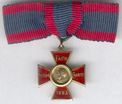
Awarded Royal Red Cross 1st Class
01 January 1917
01 January 1917
BARRY, Doris Agatha
|
Sister
AANS Born 20 September 1890 in Freshwater, SA Daughter of John Charles BARRY and Johanna nee CRALL Of Turton Street, Semaphore, SA Enlisted 29 December 1916 Aged 26 years Embarked 29 December 1916 from Sydney per 'Themistocles' Served in France Returned to Australia 13 May 1919 per 'Dunluce Castle' Appointment terminated 27 July 1919 She married Captain William Scurry MC DCM of the 50th Battalion on 29 January 1920, at St John's Catholic Church, Clifton Hill She died in Victoria 23 December 1967. Buried Lilydale Lawn Cemetery on 27 December 1967 LLC RC1-Row 1 www.awm.gov.au P03143.002 |
BARRY, Florence Beatrice
Staff Nurse
AANS
Born 1889 at Mackay, Qld.
Daughter of James BARRY and Elizabeth nee GONDON
Of Norwood Farm, Bowen Road, Mackay, Qld.
Enlisted 19 May 1917
Aged 26 years
Embarked 26 May 1917 from Sydney per 'Khiva'
Served in India
Returned to Australia 13 May 1919 per 'Eastern'
Discharged 22 February 1920
Married John MacKenzie FORRESTER
She and her husband lived in Rangoon, Burma for a time.
She died in New South Wales in 1968.
AANS
Born 1889 at Mackay, Qld.
Daughter of James BARRY and Elizabeth nee GONDON
Of Norwood Farm, Bowen Road, Mackay, Qld.
Enlisted 19 May 1917
Aged 26 years
Embarked 26 May 1917 from Sydney per 'Khiva'
Served in India
Returned to Australia 13 May 1919 per 'Eastern'
Discharged 22 February 1920
Married John MacKenzie FORRESTER
She and her husband lived in Rangoon, Burma for a time.
She died in New South Wales in 1968.
BARRY, Helena Margaret
|
Staff Nurse
Queen Alexandra Imperial Military Nursing Service Reserve Staff Nurse 2nd Australian General Hospital Depot Born Margaret Helena BARRY 24 September 1888 at Adelaide, SA Daughter of Michael BARRY and Kate nee DOOHAN Of 218 Gilles St., Adelaide, SA Trained at Adelaide Hospital Aged 27 years Embarked 20 May 1915 per 'Mooltan' at Outer Harbour to join QAIMNS Served with QAIMNSR from 22 April 1915 - 09 August 1917 Asked for discharge to join AANS Returned via Canal per 'Ventura' 14 October 1917 Enlisted with AANS 22 October 1917 Commenced duty at 7th AGH and was transferred to 'Munyara' Sanatorium 16 January 1918 Volunteered for Quarantine (Influenza) in WA Embarked 21 December 1918 via East West Railway Returned via Trans Train 12 May 1919 sick to No 7 AGH from 07 August to 22 September Demobilized 12 June 1919 at own request Approval given by P.M.O. for name to be placed on AANS AMF Reserve Page 35 of records has her discharged in London and present address in 1924 C/- Baby Health Centre, Alexandria when applying for war medals She retired from the Baby Health Clinics, Department of Health in New South Wales in 1947. Died 23 March 1979 Aged 91 years Buried Centennial Park Cemetery Derrick Gardens Path 38 Gave 691B |
BARRY, Mary Elizabeth
Staff Nurse
AANS
Born c1891 at Boolcunda East, SA
Trained at Port Pirie Hospital for three years
Aged 25 years
Enlisted 15 June 1916
Rejected - defective vision
AANS
Born c1891 at Boolcunda East, SA
Trained at Port Pirie Hospital for three years
Aged 25 years
Enlisted 15 June 1916
Rejected - defective vision
BARRY, Mary Ellen/Eleanor
Staff Nurse
AANS
Born 1892 at Mackay, Qld.
Daughter of James BARRY and Eliza Eugenie nee GONDON
Of Mackay, Qld.
NOK (sister) Mrs. S T BRIDGES
Of 'Karittia' Ourimbah, NSW
Aged 24 years
Enlisted 07 October 1916 in Sydney, NSW
Embarked No 1 Hosptial Ship 'Karoola from Melbourne 08 December 1916
Served in England
Re-embarked per 'Karoola' from Melbourne 26 February 1919
Returned to Australia 28 June 1919 per 'Karoola'
Married Kenneth McLeod Davis in NSW.
She died 13 June 1955 at Bankstown, NSW
AANS
Born 1892 at Mackay, Qld.
Daughter of James BARRY and Eliza Eugenie nee GONDON
Of Mackay, Qld.
NOK (sister) Mrs. S T BRIDGES
Of 'Karittia' Ourimbah, NSW
Aged 24 years
Enlisted 07 October 1916 in Sydney, NSW
Embarked No 1 Hosptial Ship 'Karoola from Melbourne 08 December 1916
Served in England
Re-embarked per 'Karoola' from Melbourne 26 February 1919
Returned to Australia 28 June 1919 per 'Karoola'
Married Kenneth McLeod Davis in NSW.
She died 13 June 1955 at Bankstown, NSW
BARTER, Anna Catherine Travers
Staff Nurse
Queen Alexandra's Imperial Military Nursing Service Reserve
Born 07 February 1881 in Melbourne, Vic.
Both parents deceased - father's occupation listed as Assistant Traffic Manager Victorian Railways
Educated at Parkville College, Melbourne
Trained at Melbourne Hospital, Vic. graduating 1904
Private Nursing Melbourne 1905 - 1910
Queen Charlotte's Hospital London October 1910 - February 1911
Roosevelt Hospital New York 1911 - 1917
Candiate for Harvard Unit & American Amublance, Paric
Was in New York USA and left for England 22 August arriving at Liverpool 15 September 1917 per the 'White Star'/
Served 08 October 1917 - 17 May 1919 - total of 1 years 221 days
Posted at Wharncliffe War Hospital, Sheffield, England
'Most capable and reliable in every way'
Embarked on the 'Saxonia' for New York USA 17 May 1919
Demobilized 17 May 1919
Did not marry
Died 23 November 1959 in Vic.
Late of Hawthorn, Vic.
Queen Alexandra's Imperial Military Nursing Service Reserve
Born 07 February 1881 in Melbourne, Vic.
Both parents deceased - father's occupation listed as Assistant Traffic Manager Victorian Railways
Educated at Parkville College, Melbourne
Trained at Melbourne Hospital, Vic. graduating 1904
Private Nursing Melbourne 1905 - 1910
Queen Charlotte's Hospital London October 1910 - February 1911
Roosevelt Hospital New York 1911 - 1917
Candiate for Harvard Unit & American Amublance, Paric
Was in New York USA and left for England 22 August arriving at Liverpool 15 September 1917 per the 'White Star'/
Served 08 October 1917 - 17 May 1919 - total of 1 years 221 days
Posted at Wharncliffe War Hospital, Sheffield, England
'Most capable and reliable in every way'
Embarked on the 'Saxonia' for New York USA 17 May 1919
Demobilized 17 May 1919
Did not marry
Died 23 November 1959 in Vic.
Late of Hawthorn, Vic.
BARTER, Elizabeth A (Eizzie)
|
Masseuse - probably in England (two sisters were travelling with her who were nurses and joined QAIMNSR)
Left for England May 1914 Did not marry Died 31 December 1954 in Vic. Late of Hawthorn, Vic. Here gazing out in gracious mood is Miss Elizabeth Barter, who has recently returned to Melbourne after eight months wandering about England and the Continent, on her way to her homeland after a five years' tay in America. She has wonderful tales to tell of working conditions for women in the States, and she speaks from actual experience and personal proof. She has two professions at her fingers end, for in previous days, she followed the musical profession in Melbourne, then, in order to join her sisters, who had gone to America as Proffesional nurses, she went through a course as masseuse, and, armed with her degree, set off on her travels. America is the place to make money she declares, and tells of fees and work there which prove that the pay is double and more than it is in Australia, and the consideration shown the professional woman, is also about double. She, with her sister, Miss Maude Barter, has come to Australia to look round, with, an eye to settling down into private life, but at present they are afraid that their own country has not a strong enough call of interest after their long sojourn abroad. It seems that London has the strongest pull, "because whenever you turn a corner there you come upon something of interest, something historical." As soon as they decide where they will settle the third sister, Miss Anna Barter, still in America, will join them. They are here for six months at least, however. Table Talk Thursday 14 July 1927 page 66 |
BARTER, Maud Theresa
Staff Nurse
Queen Alexandra's Imperial Military Nursing Service Reserve
Born 23 January 1883 at Ballarat, Vic.
Both parents deceased - father's occupation listed as General Traffic Manager, Victorian Railways
Matriculated from Parkville Ladies College
Trained at Melbourne Hospital - granduated June 1908 remaining on as Staff Sister and Night Superintendent
Queen Charlottes London October 1910 - February 1911
Private nursing in Australia and London
Was a candidate for the Harvard Unit & the American Ambulance, Paris
Enlisted 09 April 1917 whils in New York, USA
'My Sister and I are Australians, graduates of the Melbourne Hospital. Visiting America when war was on we joined the QAIMNS for service abroad and came over to London at our own expense. We were sent on Home service to Wharncillfe War Hospital, Sheffield and are still here. Before sigining for duration we asked what arrangements could be made for sending us to Australian after the War but except that they say the subject is under consideration we can hear nothing definite and we are being placed in the awkward postion of being stranded in London as passages for civilians are almost impossible to get. As Agent-General for Victoria would it be in your province to enquire what they inted to do for us, as we feel they owe us some reparation for not sending us abroad as the expericen gained would have been invaluable.'
She was away from Australia for sixteen years, carrying on her wowrk in both England and America.
Returned to Australia in 1927
Did not marry
Died 08 September 1958 in Vic.
Late of Hawthorn, Vic.
Queen Alexandra's Imperial Military Nursing Service Reserve
Born 23 January 1883 at Ballarat, Vic.
Both parents deceased - father's occupation listed as General Traffic Manager, Victorian Railways
Matriculated from Parkville Ladies College
Trained at Melbourne Hospital - granduated June 1908 remaining on as Staff Sister and Night Superintendent
Queen Charlottes London October 1910 - February 1911
Private nursing in Australia and London
Was a candidate for the Harvard Unit & the American Ambulance, Paris
Enlisted 09 April 1917 whils in New York, USA
'My Sister and I are Australians, graduates of the Melbourne Hospital. Visiting America when war was on we joined the QAIMNS for service abroad and came over to London at our own expense. We were sent on Home service to Wharncillfe War Hospital, Sheffield and are still here. Before sigining for duration we asked what arrangements could be made for sending us to Australian after the War but except that they say the subject is under consideration we can hear nothing definite and we are being placed in the awkward postion of being stranded in London as passages for civilians are almost impossible to get. As Agent-General for Victoria would it be in your province to enquire what they inted to do for us, as we feel they owe us some reparation for not sending us abroad as the expericen gained would have been invaluable.'
She was away from Australia for sixteen years, carrying on her wowrk in both England and America.
Returned to Australia in 1927
Did not marry
Died 08 September 1958 in Vic.
Late of Hawthorn, Vic.
Miss Maud Barter, who some years ago left Australia to follow her profession, nursing, in America, has been to Paris with an American military hospital staff. She, however, returned to America, as her sister Anna was not well. They have had great success in New York, where they are in the foremost rank of professional nurses, and they draw a salary of six guineas a week.
Table Talk Thursday 04 May 1916 page 33
Table Talk Thursday 04 May 1916 page 33
BARTLETT, Florence May
Staff Nurse
Queen Alexandra's Imperial Nursing Service
Belgian Unit British Red Cross
British Red Cross Society
Born 04 January 1885 at Newtown, Sydney, NSW
Daughter of Henry Josiah BARTLETT and Mary Ann Emma nee WILKS
Educated Presbyterian Ladies College, Croydon, NSW
Trained at Tamworth District Hospital March 1907 - March 1911
Private nursing July 1911 to June 1913
Hospital Young, NSW October 1913 - December 1914
Matron Cooma District Hospital Feburary 1915 to December 1916
Staff Nurse Military Orthopedic Hospital, London March 1917 to January 1918
Resided 6 Oakfield Road, Southgate
Appointed to QAIMNSR 28 March 1918
Served at Queen Alexandria Hospital, Grosvenor Road, SW from 28 February 1918 - 02 May 1919
Appointment terminated 02 May 1919
Returned to Australia 08 May 1919 per 'Roda'
Disembarked at Melbourne and returned to Sydney by train 11 July 1919
Queen Alexandra's Imperial Nursing Service
Belgian Unit British Red Cross
British Red Cross Society
Born 04 January 1885 at Newtown, Sydney, NSW
Daughter of Henry Josiah BARTLETT and Mary Ann Emma nee WILKS
Educated Presbyterian Ladies College, Croydon, NSW
Trained at Tamworth District Hospital March 1907 - March 1911
Private nursing July 1911 to June 1913
Hospital Young, NSW October 1913 - December 1914
Matron Cooma District Hospital Feburary 1915 to December 1916
Staff Nurse Military Orthopedic Hospital, London March 1917 to January 1918
Resided 6 Oakfield Road, Southgate
Appointed to QAIMNSR 28 March 1918
Served at Queen Alexandria Hospital, Grosvenor Road, SW from 28 February 1918 - 02 May 1919
Appointment terminated 02 May 1919
Returned to Australia 08 May 1919 per 'Roda'
Disembarked at Melbourne and returned to Sydney by train 11 July 1919
Matron (Miss F M Bartlett) leaves Cooma at the end of the month to offer her services for war nursing.
The Manaro Mercury,and Cooma and Bombala Advertiser Friday 03 November 1916 page 2
The Manaro Mercury,and Cooma and Bombala Advertiser Friday 03 November 1916 page 2
BARTLETT, Ivy Florence McIntosh
Staff Nurse
AANS
Born 1884 at Wodonga, Vic.
Daughter of Sydney BARTLETT and Mary nee THORNBURN
Of Corryong, Vic.
Enlisted 04 August 1915
Aged 31 years
Embarked 04 August 1915 from Melbourne per 'Orontes'
Embarked 25 September 1917 from Sydney per 'Kanowna'
Served in Egypt
Returned to Australia per 'Kanowna'
Appointment terminated 17 May 1919
Married in 1926 to Percival Ferry THWAITES.
Died December 1964 in Heidelberg, Vic.
Cremated 23 December 1964 at Springvale Botanical Cemetery and ashes scattered
AANS
Born 1884 at Wodonga, Vic.
Daughter of Sydney BARTLETT and Mary nee THORNBURN
Of Corryong, Vic.
Enlisted 04 August 1915
Aged 31 years
Embarked 04 August 1915 from Melbourne per 'Orontes'
Embarked 25 September 1917 from Sydney per 'Kanowna'
Served in Egypt
Returned to Australia per 'Kanowna'
Appointment terminated 17 May 1919
Married in 1926 to Percival Ferry THWAITES.
Died December 1964 in Heidelberg, Vic.
Cremated 23 December 1964 at Springvale Botanical Cemetery and ashes scattered
Nurse Ivy Bartlett writes, from the Australian General Hospital, Lemnos, under date 16th October :—You would never think that on this island we were so near the firing line. I would like to get nearer, and wish they could get enough safe land on the Peninsula to have a hospital there, as it would be much handier than this place. Having to ship and unship every-one is such a work. A lot of the largest boats are turned into hospital ships. There were seven in the harbor last night, and to night the is in. She is one of the largest boats in the world. They have a line of green lights along the side and a big red cross (lit up), and look very pretty. It has been very cold the last few days and fearfuiiy windy. The tents are in danger of breaking loose, and the boys are always hammering at the tent pegs. It is strange to think you must be well into spring, when we are just starting winter. The mud is dreadful, and sticks like glue. Colonel was here to day, and suggested several improvements. Also he says skirts are quite unsuitable in such a place in such rough weather ! There is plenty of work. Typhoid is running high. Several new wards have been added, and we have over 1,000 beds — all under canvas. There are very few surgical cases—they go to Alexandria. The food is our pet grievance. I am not fussy about what I have usually, but I hope there will soon be a change. Nurse Hughes and I share a bell tent. It is right on the sea, and we can see the boats buzzing about from our beds. We can hear the Gallipoli bombarding here. It sounds just like blasting. I went over to the Rest Camp one Sunday, and found Mr Say and Walter Cunningham. Walter has been in hospital at Malta.
Corryong Courier Thursday 09 December 1915 page 3
Corryong Courier Thursday 09 December 1915 page 3
BARTLETT, May
|
Sister
AANS Born 1885 in Bathurst, NSW Daughter of Richard Clifford BARTLETT and Jane nee SMITH Of 228 Hammersley Road, Subiaco, WA Trained at Perth Public Hospital, WA Embarked 22 July 1915 per 'Kanowna' for hospital ship duty Returned to Melbourne 08 April 1916 per "Kanowna' Aged 30 years Re-embarked 22 August 1916 per 'Mooltan' for British Indian Service Served in Bombay Returned to Australia per 'Megantic' 13 February 1920 Appointment terminated 10 March 1920 Did not marry Died 21 May 1971 in Perth, WA Aged 85 years Resided Bentley, WA Buried Karrakatta Cemetery Seventh Day Adventist BA 0116 (as Mary BARTLETT) Western Mail Friday 16 November 1917 page 6s |
BARTON, Annie
|
Matron
AANS Home Service Born 1883 in Geelong, Vic. Daughter of Rev. John BARTON and Ann Eliza nee DUNCAN Married Dr. John Hodgson NATTRASS John died 04 December 1943 Died 1965 in Caulfield, Vic. When Miss A. Barton took charge of the Base Hospital, St. Kllda road, she did not face an easy task. Military hospitals, so far as Australia was concerned, were then in the experimental stage, and the pioneer workers had all the inevitable obstacles of a new activity to overcome. Useful service to her country in the time of need secured for
Miss Barton the Royal Red Cross (Second Class). Miss Barton trained at the Melbourne Hospital. |
BASS, Marie Madeline Goulee
|
Sister
AANS Born Marie Madeline Goulee BASTARD in St. Leonards, Sydney, NSW Daughter of Frederick & Eliza BASTARD (changed their surname to Bass) Of 'Lyndyn' Inkerman Street, Mosman, NSW Enlisted 11 May 1917 Aged 26 years Embarked 09 June 1917 from Sydney per 'Mooltan' Served in Salonika Returned to Australia 10 August 1919 per 'Konig Frederich August' Appointment terminated 10 September 1919 Did not marry Died 03 February 1980 at Mosman, NSW |
BASSETT, Maud Emily Victoria
Staff Nurse
AANS
Born 1894 at Gayndah, Qld.
Daughter of Cornelius John BASSETT and Mary nee COLEMAN
Of Longreach, Qld.
Enlisted 02 November 1918 at Gayndah, Qld.
Aged 24 years
Embarked 09 November 1918 from Sydney per 'Wiltshire'
Served in India
Returned to Australia 27 July 1919 per 'Hungaria'
Appointment terminated 12 August 1919
Did not marry
Died 06 November 1923 at St. Martin's Private Hospital, Queensland
Buried Toowong Cemetery 5 106 33
The sad news of the death of Sister Maud Basset, late of A.I.F., came as a shock to the residents of Yarraman, where she is fairly well known. While abroad the unfortunate girl contracted lung trouble, and she passed away at St. Martin's Hospital early on Thursday morning. Her three sisters are: Mesdames Lang, McIvor, and Thannett, of Yarraman, and her only brother is Mr. Jack Bassett. Much sympathy is expressed for her relatives as only in February last they lost their mother.
Queensland Times Friday 14 September 1923 page 7
AANS
Born 1894 at Gayndah, Qld.
Daughter of Cornelius John BASSETT and Mary nee COLEMAN
Of Longreach, Qld.
Enlisted 02 November 1918 at Gayndah, Qld.
Aged 24 years
Embarked 09 November 1918 from Sydney per 'Wiltshire'
Served in India
Returned to Australia 27 July 1919 per 'Hungaria'
Appointment terminated 12 August 1919
Did not marry
Died 06 November 1923 at St. Martin's Private Hospital, Queensland
Buried Toowong Cemetery 5 106 33
The sad news of the death of Sister Maud Basset, late of A.I.F., came as a shock to the residents of Yarraman, where she is fairly well known. While abroad the unfortunate girl contracted lung trouble, and she passed away at St. Martin's Hospital early on Thursday morning. Her three sisters are: Mesdames Lang, McIvor, and Thannett, of Yarraman, and her only brother is Mr. Jack Bassett. Much sympathy is expressed for her relatives as only in February last they lost their mother.
Queensland Times Friday 14 September 1923 page 7
BASSETTI, Jessie
|
Staff Nurse
AANS Born 1881 in Redfern, Sydney, NSW Daughter of John Baptiste BASSETTI and Susannah nee PLAYFAIR Sister of M P ACKLAND Of 'Yerom' Arburtus Street, Mosman, NSW Enlisted 10 May 1917 Aged 32 years Embarked 09 June 1917 from Sydney per 'Mooltan' Served in Salonika Returned to Australia 04 September 1919 per 'Friedrichsruh' Appointment terminated 03 November 1919 Did not marry Died 30 October 1929 at Cremorne, NSW Buried Rookwood Cemetery Church of England |
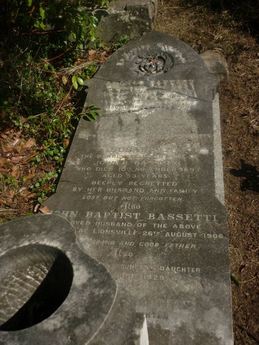
SISTER BASSETTI
Sister Jessie Bassetti, who died at a private hospital at Cremorne, on 30th October, was well known to many Penrith residents. She went, through her training at Nepean District Hospital under Matron Major West, many years ago. During the Great War, practically the whole of the staff of the Hospital (five in all) enlisted for active service, Sister Bassetti being one of the number. The others wore:—Matron Major West, and Nurses D.. Baker, Greentree, and Seahill.
After serving on the other side for a considerable period, Sister Bassetti returned to Sydney. On the way home she suffered an injury from which she never recovered, and died, as stated, after a very long and painful illness. Deceased was well liked by all who knew her, because of her very bright nature.
The funeral took place this Friday, the remains being laid to rest in the Church of England portion of the Rookwood cemetery.
Nepean times Saturday 02 November 1929 page 4
Sister Jessie Bassetti, who died at a private hospital at Cremorne, on 30th October, was well known to many Penrith residents. She went, through her training at Nepean District Hospital under Matron Major West, many years ago. During the Great War, practically the whole of the staff of the Hospital (five in all) enlisted for active service, Sister Bassetti being one of the number. The others wore:—Matron Major West, and Nurses D.. Baker, Greentree, and Seahill.
After serving on the other side for a considerable period, Sister Bassetti returned to Sydney. On the way home she suffered an injury from which she never recovered, and died, as stated, after a very long and painful illness. Deceased was well liked by all who knew her, because of her very bright nature.
The funeral took place this Friday, the remains being laid to rest in the Church of England portion of the Rookwood cemetery.
Nepean times Saturday 02 November 1929 page 4
BASSETTI, Virginia May (Virgie)
|
Embarked 09 December 1916 per 'Kaiser-i-Hind'
Served in Egypt and France Suffered from Diptheria Returned to Australia 24 March 1919 per 'Lancashire' Appointment terminated 03 May 1919 Did not marry Died 13 April 1939 at Royal Hospital for Women, Padding, NSW Buried Rookwood Cemetery The late SISTER VIRGINIA MAY BASSETTI, one of the first sisters to leave Australia with the A.I.F., whose death has occurred at the Royal Hospital for Women, Paddington, where she was for many years on the staff. Sydney Morning Herald Monday 24 April 1939 page 17s SISTER V. M. BASSETTI Sister Virginia May Bassetti was well known known to members of the AIF died in the Royal Hospital for Women, Paddington, on Thursday after a short illness. Sister Bassetti was one of the first sisters to leave Australia with the AIF and served in Egypt and later France. She was a cheerful personality and very popular. Her sister Jessie also served with the AIF. Another sister is Mrs A. F. Yeldham who is well known in golf circles. On her return to Australia, Sister Virginia Bassetti was connected with the Royal Hospital for Women, Paddington, for a number of years. A service was held at St George's Church of England, Paddington, yesterday afternoon, a guard of honour of nurses being present. The funeral was held at the Church of England Cemetery, Rookwood. Sydney Morning Herald Saturday 15 April 1939 page 22 |
BATE, Mary Russell
|
Sister
AANS Born 1877 at Pleasant Creek, Vic. Daughter of Henry Clifford BATE and Elizabeth Ann nee RUSSELL Of 'Kemsley', Stawell, Vic. Enlisted 16 October 1915 Aged 36 years Embarked 04 November 1915 Enlisted 25 March 1916 at Heliopolis, Egypt Served in Egypt and France Returned to Australia per 'Derbyshire' 22 April 1919 Appointment terminated 09 July 1919 Died 25 April 1962 in Stawell, Victoria. |
www.awm.gov.au
P04125.013
P04125.013
BAUDINET, Flora Isabel aka Dora Isobel
|
Staff Nurse
AANS 1st Australian General Hospital Born Bairnesdale, Gippsland, Vic. Daughter of Edmund Chaulk BAUDINET and Helen Jane nee McKAY Of 336 Murray Street, Hobart, Tas. Occupation prior to enlistment Nurse Aged 32 years Enlisted 15 June 1915 Embarked 17 June 1915 per 'Wandella' Served in France Returned to Australia 24 October 1917 per 'Benalla' Discharged 12 November 1917 in Hobart, Tas. Died 19 December 1945 in Hobart, Tas. Aged 63 years Resided Hobart, Tas. Cremated Cornelian Bay Cemetery Buried Cornelian Bay Cemetery Derwent Gardens Aust. Imp. Force Arch 1 North 2 H |
Amongst the Australian nurses leaving shortly for the seat of war is Nurse Baudinet, who is one of our own trained nurses, and has had a great deal of experience, both in hospital and private nursing. Mrs. C S Simmons, of Melville street arranged a farewell afternoon for her last week, and between 50 and 60 friends of the nurse accepted the invitation. During the afternoon Mr. S Clemes on behalf of those present, handed to Nurse Baudinet a fine travelling rug, and all united in wishing her bon voyage, a useful career, and safe returned.
The Mercury Wednesday 09 June 1915 page 4
The Mercury Wednesday 09 June 1915 page 4
|
Death Of Sister Baudinet
Fine Record Of Service A SPLENDID record of service to humanity, in the Army Nursing Service in the First World War, and in various community activities in Tasmania ended with the death of Sister Dora Baudinet at Hobart yesterday. Sister Dora Baudinet was the daughter of the late Mrs Helen Baudinet, of 336 Murray St., and the late Mr Baudinet. She was educated at the Friends' School and has since taken a keen interest in the school's welfare as a vice-president of the Old Scholars' Association. After a few years as a teacher in the Education Dept., she took up nursing. She trained under Matron Johnstone-Turnbull at the Hobart General Hospital (now the Royal Hobart Hospital), and on completion of her training did private nursing. She enlisted for active service in the First World War in the Australian Army Nursing Service, and served with No. 1 Australian General Hospital at Heliopolis (Egypt) and Rouen (France). |
|
She was also on hospital ship duty, and on her return to Tasmania was on the staff of the military hospitals at Roseneath and Hornsey. After dis-charge from the Army, she was on the nursing staff of the Repatriation Hospital, Hobart, and later left to take the position of schools' nurse for the Education Dept., which work she carried on for many years, retiring last year.
Sister Baudinet had been an active member of the Returned Army Sisters' Association since its inception, and at the time of her death was president; she had been home secretary of the Army Sisters' Memorial Home at Lindisfarne for the past 20 years. She was a foundation member of the Nurses' Club and Bureau, worked hard to establish it in 1922, and had been an active member of the committee since. Sister Baudinet was organising secretary for the raising of funds for the Sunshine Home, soon to be built at Howrah. This home is in tended for State school children of Tasmania who need medical attention or a curative change or rest, and she has worked for it un-sparingly. It is regretted that because of war-time building restrictions, she has not lived to see the project an accomplished fact. She was a member of the Memorial Church, and was interested in the Youth Movement within the church. Her brother, Mr Sefton Baudinet,of Sydney, is in Hobart. Cremation takes place at Cornelian Bay cemetery this afternoon. The Mercury Thursday 20 December 1945 page 8 Photograph http://stors.tas.gov.au/PH30-1-5306 |
|
SISTER DORA BAUDINET
The cremation of Sister Dora Baudinet, who had a fine record as an army nurse in the First World War, took place at Cornelian Bay yesterday. Sister Baudinet died at Hobart on Wednesday Mr. Sefton Baudinet (brother) was the chief mourner. Services were conducted by Revs. H. S. Grimwade and H. J, Ralph. Educated at the Friends' School, Hobart, Sister Baudinet was a vice president of the Old Scholars' Association. She trained at the Hobart General Hospital (now the Royal Hobart Hospital). Enlisting for active service in the First World War with the Australian Army Nursing Service, she served with No. 1 Australian General Hospital at Heliopolis (Egypt)and Rouen (France). On her return to Tasmania she joined the staff of the military hospitals at Roseneath and Hornsey. She was schools' nurse for the Education Department for many years. She retired from the department last year. At the time of her death Sister Baaudinet was president of the Returned Army Sisters' Association. She was organising 'secretary for the raising of funds for the Sunshine Home, soon to be built at Howrah. Funeral arrangements were made by Alex Clark and Sons. Examiner Friday 21 December 1945 page 4 |
BAUDINET, Mabel Chaulk
Staff Nurse
AANS
Born 1886 at Ballarat, Vic.
Daughter of Francis Kent BAUDINET and Emma Eliza Chaulk nee NORRIS
Of Bairnsdale, Vic.
Trained at Bairnsdale District Hospital
Enlisted 06 August 1917 at Melbourne, Vic.
Aged 31 years
Embarked 16 November 1917 from Sydney per 'Canberra'
Disembarked at Bombay
Served in India
Returned to Australia 22 May 1918 per 'Kanowna'
Appointment terminated 25 November 1918
Died 29 January 1928 in Melbourne, Vic.
Interred at Dandenong
Widespread regret will be felt, particularly among members of the A.I.F. at the death of Sister Mabel Baudinet, of Lake Victoria, which took place at a private hospital in Melbourne on Sunday last. Sister Baudinet trained as a nurse at the Bairnsdale Hospital and on the outbreak of war offered her services to her country. She was later accepted and detailed for duty in India. On returning from the war in May 1918 as a cot case, and with her health definitely broken, Sister Baudinet struggled bravely to return to her previous work. She was still quite a young woman at her death and is one more to add to the ever increasing list of post war casualties, which almost daily accrues to the sum of Australia's sacrifice. the remains were privately interred at Dandenong.
Gippsland Times Monday 06 February 1928 page 3
AANS
Born 1886 at Ballarat, Vic.
Daughter of Francis Kent BAUDINET and Emma Eliza Chaulk nee NORRIS
Of Bairnsdale, Vic.
Trained at Bairnsdale District Hospital
Enlisted 06 August 1917 at Melbourne, Vic.
Aged 31 years
Embarked 16 November 1917 from Sydney per 'Canberra'
Disembarked at Bombay
Served in India
Returned to Australia 22 May 1918 per 'Kanowna'
Appointment terminated 25 November 1918
Died 29 January 1928 in Melbourne, Vic.
Interred at Dandenong
Widespread regret will be felt, particularly among members of the A.I.F. at the death of Sister Mabel Baudinet, of Lake Victoria, which took place at a private hospital in Melbourne on Sunday last. Sister Baudinet trained as a nurse at the Bairnsdale Hospital and on the outbreak of war offered her services to her country. She was later accepted and detailed for duty in India. On returning from the war in May 1918 as a cot case, and with her health definitely broken, Sister Baudinet struggled bravely to return to her previous work. She was still quite a young woman at her death and is one more to add to the ever increasing list of post war casualties, which almost daily accrues to the sum of Australia's sacrifice. the remains were privately interred at Dandenong.
Gippsland Times Monday 06 February 1928 page 3
BAXTER, Jessie MacDonald
|
Sister
AANS Born 1883 in Sydney, NSW Daughter of Robert BAXTER and Margaret nee BURNETT Of 'Canonbury' 242 Glebe Road, Glebe Point, NSW Enlisted 20 March 1915 Aged 29 years Embarked 13 April 1915 per 'Kyarra' from Sydney, NSW Served in France Invalided from France to England 12 August 1916 Returned to Australia 03 April 1917 per 'Mooltan' Re-embarked 12 June 1917 in Melbourne per 'Mooltan' Embarked from Port Said for Salonika 25 July 1917 per 'Gragres' Served in Salonika Returned to Australia 15 December 1919 per 'Wahehe' Appointment terminated 14 January 1920 She married Dr Donald Clark in Athens. There are newspaper articles about them helping refugees in Salonika in the 1920's where conditions must have been terrible. They arrived Sydney 17 February 1926. Dr Clark died 12 October 1928 at the Randwick Military Hospital. Jessie died 19 March 1955 at Killara, NSW. Late of Linfield, NSW |

Awarded Royal Red Cross (2nd Class)
Date of Commonwealth of Australia Gazette: 23 May 1919
Location in Commonwealth of Australia Gazette: Page 891, position 40
Date of London Gazette: 1 January 1919
Location in London Gazette: Page 77, position 3
Date of Commonwealth of Australia Gazette: 23 May 1919
Location in Commonwealth of Australia Gazette: Page 891, position 40
Date of London Gazette: 1 January 1919
Location in London Gazette: Page 77, position 3
|
Sister J.M. Baxter, who recently returned from the front, where she was mentioned in despatches, is a daughter of Mr. and Mrs. R. Baxter, of Glebe Point, Sydney. She received her training at the Coast Hospital.
Sister Baxter, with a number of Sydney nurses left in April 1915 for Egypt. She was attached to the Luna Park Hospital in Heliopolis where the patients were mostly Australian boys. A fortnight after her arrival the landing at Gallipoli took place, when the doctors and nurses had such a strenuous and anxious time. At that time the nurses wore the grey frock, short red cape and bonnet, and they were very pleased when the order came for a change of uniform to the grey coat and skirt and felt hat, which they now wear. In April 1916, sister Baxter left Egypt for Marseilles. The Australians' first impression of France was gained under happy circumstances, for, to use her own words, 'everything was in blossom, and it was a gorgeous train journey to Paris.' The nurses stayed for a few days in Rouen where the Australian Hospital is stationed, and from whence 50 of their own unit were distributed in English hospitals. Sunday Times (Sydney) Sunday 20 May 1917 page 17 |
AMONG THE REFUGEES.
AN AUSTRALIAN AT WORK.
The war was responsible for taking many Australian men and women to far-away parts of the globe, and among those who continued to find their life work in distant places is Mrs. Clarke, wife of Dr. Clarke, wbo holds an Imperial appointment at Salonica. As Sister Jessie Baxter, daughter of Mr. and Mrs. R. Baxter, Glebe Point, she served with the Australian nursing division during the period of the war, and was awarded the Royal Red Cross. For the last year Dr. and Mrs. Clarke, have been at Salónica, where they are doing a noble work among the stricken refugees. The sufferings of the wretched men and women and the worrying time that those in attendançe are experiencing may be judged from recent communications from Mrs. Clarke, who at the time of writing was the only trained nurse in the camp of between 7000 and 8000. "The refugees," she writes, "arrive in boat loads, unclothed, unled, unwashed, and ill. Every third woman is an expectant mother, and the babies are born in any little corner the poor wretched things can find. . Numbers have died from starvation and exposure. There are families of young children among them without father or mother, struggling along, frightened and dazed." The English colony, she goes on to say, has collected a lot of money, and the Americans have assisted in the same way. The British and American Red Cross have also given wonderful help. Dr. Clarke was the only medical man at the camp, and there were very few helpers. The refugees are housed in old British camps, but the huts are in a bad condition, and the people are lying on the bare floors without coverings. Some of the other camps are in a much worse condition. Mrs. Clarke states that it is extremly difficult to get the authorities to do anything In the way of sanitation, "and," she continues, "one cannot picture or attempt to describe the filth of thousands of people huddled together, crawling with vermin, no water supply, and no proper lavatories".
Sydney Morning Herald Saturday 20 January 1923 page 9
AN AUSTRALIAN AT WORK.
The war was responsible for taking many Australian men and women to far-away parts of the globe, and among those who continued to find their life work in distant places is Mrs. Clarke, wife of Dr. Clarke, wbo holds an Imperial appointment at Salonica. As Sister Jessie Baxter, daughter of Mr. and Mrs. R. Baxter, Glebe Point, she served with the Australian nursing division during the period of the war, and was awarded the Royal Red Cross. For the last year Dr. and Mrs. Clarke, have been at Salónica, where they are doing a noble work among the stricken refugees. The sufferings of the wretched men and women and the worrying time that those in attendançe are experiencing may be judged from recent communications from Mrs. Clarke, who at the time of writing was the only trained nurse in the camp of between 7000 and 8000. "The refugees," she writes, "arrive in boat loads, unclothed, unled, unwashed, and ill. Every third woman is an expectant mother, and the babies are born in any little corner the poor wretched things can find. . Numbers have died from starvation and exposure. There are families of young children among them without father or mother, struggling along, frightened and dazed." The English colony, she goes on to say, has collected a lot of money, and the Americans have assisted in the same way. The British and American Red Cross have also given wonderful help. Dr. Clarke was the only medical man at the camp, and there were very few helpers. The refugees are housed in old British camps, but the huts are in a bad condition, and the people are lying on the bare floors without coverings. Some of the other camps are in a much worse condition. Mrs. Clarke states that it is extremly difficult to get the authorities to do anything In the way of sanitation, "and," she continues, "one cannot picture or attempt to describe the filth of thousands of people huddled together, crawling with vermin, no water supply, and no proper lavatories".
Sydney Morning Herald Saturday 20 January 1923 page 9
|
FOR WOMEN WAR WORKERS.
RETURN OF AUSTRALIAN SISTER. Among the passengers who arrived by the Hobsons Bay were Dr. and Mrs. Donald Clark. Dr. Clark, who rendered meritorious service during the war, was after the armistice appointed medical officer to the reconstruction camps at Salonika. Mrs. Clark will be better remembered as Sister Jessie M. Baxter, who is a trainee of the Coast Hospital. She served for four and a half years at the war. She was first in Egypt, and later in France always on the frontier at the receiving stations. She also did transport duty to England, and for a few months was at Southall Hospital. Sister Baxter was twice mentioned In despatches and was awarded the R.R.C. She then came to Sydney on transport duty, and after her return was on duty at the Randwick Military Hospital. Later, when 300 nurses were sent to Salónica in charge of Matron McHardle White, Sister Baxter went with them. They arrived at Salónica a few days before the big fire, when the soldiers had to use force to get the women to leave their homes and go to the camp provided by the British for their care and comfort. |
Dr. and Mrs. Clark were in Salónica whenthe big influx of refugees took place. This experience was eventful, for thousands came, starving and destitute, and the maternal mortality was particularly high. Dr. Clark established a hospital at Hooven Keny; he got help, clothing, and medicine from friends in England. There were 8000 refugees in this hospital alone, and Mrs. Clark was the only trained woman there. For this good work Dr. and Mrs. Clark each received a letter of appreciation from the acting Consul-General,in which be stated that the principal Acting Secretary of State for Foreign Affairs had notified him that Lord Curzon had learnt of their work, and appreciated the great personal risk, and self sacrifice which it had entailed, and had expressed his appreciation of it. During the recent revolutions in Greece Dr. Clark's house was in the direct line of fire. His gardener was shot, but recovered from his injuries. Dr. and Mrs. Clark Intend making their home in Sydney.
The Sydney Morning Herald Friday 4 March 1927 page 4
The Sydney Morning Herald Friday 4 March 1927 page 4
BAXTER, Kathleen Mary
|
Kathleen Mary Baxter was born in Sydney in 1886. She was the daughter of John Baxter and Mary nee Doheny/Doheney of Burwood, NSW
Kathleen was engaged to Mr. E.P. Hollingdale, of Burwood in August 1912 with the wedding set for October 1912 - appears the wedding did not go ahead. Was in England when war broke out. She too was a nurse (according to newspaper articles) although her name does not appear on UK Archives as her two sisters. She married Lieutentant George Robinson Renshaw of the Royal Navy Reserve 11 Janury 1915 in London at the Church of Our Lady, Grove Road, St. John's Wood. Her husband was killed at sea on HMS Defence 31 May 1916. Kathleen remained in England for some but eventually went to New Zealand and died there 10 January 1962. Buried at Our Lady of the Sea Catholic Church. |
Miss Kathleen Baxter is among recent arrivals In London. She will stay with her sisters Miss Margaret Baxter, until July, and then will tour Scotland, Wales, and Ireland.
Evening News Tuesday 27 May 1913 page 8
Evening News Tuesday 27 May 1913 page 8
A portrait of Mrs. George Renshaw (Miss. Kathleen Baxter) appears in. the 'Lady's Field' of February 6., with the -following description of her wedding in London. At the Church of Our Lady, St. John's Wood, by the Very Rev. Canon Brennan, on January 11th, Kathleen, youngest daughter of John Baxter, of 'Breffin,' Burwood, New South Wales, Australia, to Lieutenant George Robinson Renshaw, R.N.K., of H.M.S. Defence. Owing to the marriage taking place during the bridegroom's, short leave, only immediate friends and relations were present.
Sir John Taverner gave the bride away. Miss Gertrude Hogan was bridesmaid;- and - Master Jack Taverner, in khaki, was page. The bride wore mole-coloured velvet trimmed with skunk, hat with Rose du Barri feather encircling it.
Freeman's Journal Thursday 25 March 1915 page 28
Sir John Taverner gave the bride away. Miss Gertrude Hogan was bridesmaid;- and - Master Jack Taverner, in khaki, was page. The bride wore mole-coloured velvet trimmed with skunk, hat with Rose du Barri feather encircling it.
Freeman's Journal Thursday 25 March 1915 page 28
BAXTER, Margaret
Lady Rachel Dudley's Unit
Australian Voluntary Hospital
St. Nazaire, France
Margaret Baxter was born in 1868 and was the daughter of John Baxter and Mary nee Doheny/Doheney.
Arrived in England before the war and worked as a journalist.
In her father's obituary it mentions that his three daughters were nurses in the war.
Awarded MBE in 1935 for Empire work and war work.
Died 06 May 1945 in London
Australian Voluntary Hospital
St. Nazaire, France
Margaret Baxter was born in 1868 and was the daughter of John Baxter and Mary nee Doheny/Doheney.
Arrived in England before the war and worked as a journalist.
In her father's obituary it mentions that his three daughters were nurses in the war.
Awarded MBE in 1935 for Empire work and war work.
Died 06 May 1945 in London
|
Miss Maggie Baxter, an Australian domiciled in Europe for a number of years past, has gone to France at the invitation of the Education committee of the War Office, which has at its head Colonel Lord Gorrell. Miss Baxter is giving a course of lectures to the British troops still there, on the social and industrial aspects of Australia. The High Commissioner for Australia has lent a collection of lantern slides, which Miss Baxter will use in conjunction with her lectures. She is the third woman to be sent to France for this purpose. On her return to London, Miss Baxter will give a series of illustrated lectures on Australia to the inmates of the military hospitals in Great. Britain on the invitation of the Education Committee of the Victoria League. Since the war began, Miss Baxter has succeeded in raising a sum of £100,000 for various charities, and has acted as hon. organiser to the Australian section for all the Allied war appeals.
The Farmer and Settler Friday 16 May 1919 page 8 |
MISS MARGARET BAXTER, who to the first Australian woman to be elected a member of the Council of the Royal Empire Society, has a distinguished record. She was also reelected to the Advisory of the Social Committee of the Society at their annual meeting in June (says "The
British Australian and New Zealander"). Among Miss Baxter's many activities in the past was the fine work. she did during the war, when, in August, 1914, she was elected representative of the Lyceum Club on the International Women's Relief Committee which succoured innumerable women and children left homeless and stranded in London. She was one of the first women civilians allowed to visit base hospitals in France and Belgium and in England. She collected about £150,000 for various war charities. Miss Baxter was also the organiser and secretary of the Australian section for all the allied war appeals. After the Armistice she went to France in 1919 at the invitation of the Education Committee of the War Office, whose head, Colonel Lord Gorell. said that her "matchless" knowledge of the Empire would be invaluable in the committee's scheme of lectures. Miss Baxter was the guest of G.H.Q. in France, and visited the bases lecturing with films and slides before going on to Belgium to repeat her success with the Home and Dominion troops in the Charlerol district Organiser of Sailors' Day in London, honorary organiser of the Jubilee Empire Fair, of Dr. Bamardo's Homes, of the Christmas Market Fair for the Royal Waterloo Hospital for Women and Children, chairwoman of the Women's Committee of the Pageant of Empire at the British Empire Exhibition at Wembley are only a few
of the positions she has held. Miss Baxter was very proud, when in Canada, of being elected an honorary member of Lord Roberts' Chapter, and
an honorary vice-regent of the 17th Regiment Chapter, London, Ontario, of the Imperial Order of the Daughters of the Empire. The Royal Empire
Society is lucky to get such an out standing personality as Miss Baxter's on its council.
The Queenslander Thursday 27 July 1933 page 34
British Australian and New Zealander"). Among Miss Baxter's many activities in the past was the fine work. she did during the war, when, in August, 1914, she was elected representative of the Lyceum Club on the International Women's Relief Committee which succoured innumerable women and children left homeless and stranded in London. She was one of the first women civilians allowed to visit base hospitals in France and Belgium and in England. She collected about £150,000 for various war charities. Miss Baxter was also the organiser and secretary of the Australian section for all the allied war appeals. After the Armistice she went to France in 1919 at the invitation of the Education Committee of the War Office, whose head, Colonel Lord Gorell. said that her "matchless" knowledge of the Empire would be invaluable in the committee's scheme of lectures. Miss Baxter was the guest of G.H.Q. in France, and visited the bases lecturing with films and slides before going on to Belgium to repeat her success with the Home and Dominion troops in the Charlerol district Organiser of Sailors' Day in London, honorary organiser of the Jubilee Empire Fair, of Dr. Bamardo's Homes, of the Christmas Market Fair for the Royal Waterloo Hospital for Women and Children, chairwoman of the Women's Committee of the Pageant of Empire at the British Empire Exhibition at Wembley are only a few
of the positions she has held. Miss Baxter was very proud, when in Canada, of being elected an honorary member of Lord Roberts' Chapter, and
an honorary vice-regent of the 17th Regiment Chapter, London, Ontario, of the Imperial Order of the Daughters of the Empire. The Royal Empire
Society is lucky to get such an out standing personality as Miss Baxter's on its council.
The Queenslander Thursday 27 July 1933 page 34
BAXTER, May
|
Lady Rachel Dudley's Unit
Australian Voluntary Hospital St. Nazaire, France Daughter of John BAXTER and Mary nee DOHENY/DOHENEY Of 'Breffni' Burwood, NSW Trained at Prince Alfred Hosptial, Sydney Formerly Matron of the Tamworth Hospital Left Australia via 'Osterley' 10 April 1912 on a trip to Europe. May was already working in England when War broke out. Awarded Royal Red Cross www.awm.gov.au P01064.006 |
|
Miss May Baxter, who left for London early in the year to join her sister in the Big Smoke, has taken up nursing at one of the London hospitals. She has been fortunate enough to secure a position on the staff of the Harold Fink Private Hospital at 17 Park Lane.
Freeman's Journal Thursday 30 October 1913 page 28 |
The appointment of Nurse May Baxter as Matron of the Military Hospital, under the War Office control, at 5 Grosvenor Square, London, will be read of with interest by the numerous friends of the family. Nurse Baxter, who, for some years before she left Australia was matron of Tamworth Hospital, was one of the first to offer her services to Lady Dudley when the Australian Voluntary Hospital, Wimereux, was being equipped, and was one of the nursing staff when the first batch of wounded arrived, at very short notice.
Freeman's Journal Thursday 16 September 1915 page 26
Freeman's Journal Thursday 16 September 1915 page 26
Miss May Baxter, formerly of Strathfield, and now matron of the Coultie Hospital, Grosvenor Square, London, was honored last month by a, visit from their Majesties King George and Queen Mary.
Their Majesties stayed over two hours chatting to each of the wounded tn turn, and when leaving expressed their admiration, of the perfect equipment, comfort, and general delightful atmosphere, of the hospital. Supporting Matron Baxter in her. reception of their Majesties were. Captain Reynell and Lady Juliet Duff.
The Mirror of Australia Saturday 13 May 1916 page 12
Their Majesties stayed over two hours chatting to each of the wounded tn turn, and when leaving expressed their admiration, of the perfect equipment, comfort, and general delightful atmosphere, of the hospital. Supporting Matron Baxter in her. reception of their Majesties were. Captain Reynell and Lady Juliet Duff.
The Mirror of Australia Saturday 13 May 1916 page 12
News comes of Miss May Baxter, who until recently was matron of the Wimereux Hospital. Lady Janet Duff and other noted society women took the Duke of Marlborough's house in Grosvenor-square, and have opened it as a private hospital for soldiers. Miss May Baxter is in charge, and at her suggestion 16 beds in one ward have been dedicated to the memory of Australian soldiers. Several Australian women in England have endowed the beds in memory of their relatives or friends, and on each bed is a brass plate bearing the name of the fallen hero.
Sunday Times (Sydney) Sunday 21 May 1916 page 26
Sunday Times (Sydney) Sunday 21 May 1916 page 26
|
Not in the proverbial nutshell, but a small par, is this, the story of three smart Australian girls who made good, better, and best — Margaret, May, and Kathleen Baxter, daughters of Mr. J. Baxter, "Breffin," Burwood. When Germany shook up the world, they were in London, and all got busy. May, the Nightingale of the picture, happened to enjoy the friendship of Lady Dudley. Hence a nursing post in France, and later in charge of the Coulter Hospital, with another friend, Lady Juliet Duff, as the commandant. For good work so truly done Sister May now wears the Mons Medal. The R.P.A. here owns her as a trainee, and now she comes home for a spell, having been offered bye-and-by the charge of a well-known hospice locally. Sister Margaret is lecturer, nurse, press woman, moving spirit of London's Lyceum Club, friend of royalty, nobility, and the poor, and with another sister, Kathleen, also a war worker of repute, will come south to see the old home, and say how-do to Dad. Brother Frank has worn khaki since the beginning of the scrapping, and makes the fourth member of the family to be magnetised by the wish to put their Australian feet once more on the dear home land.
The Sun (Sydney) Sunday 24 August 1919 page 15 |
BAXTER, Violet Phoebe Cobbing
Staff Nurse
AANS
Born Violet Phoebe COBBING 10 August 1890 in Launceston, Tas.
Mother married William Maxwell BAXTER in 1896
Daughter of William Maxwell and Phoebe BAXTER
Of 'Waestead' Eastbourne Street, Cottesloe Beach, WA
Enlisted 07 May 1917 at NO 8 AGH Fremantle, WA
Aged 25 years
Embarked 22 May 1917 from Fremantle WA per 'Benalla'
Served in England
Returned to Australia 06 January 1919 per 'Takada'
Appointment terminated 27 February 1919
Violet married 1919 in Victoria to Harry Leslie Downe. He was a soldier in WW1.
Died 17 June 1971
Aged 79 years
Resided Floreat Park, WA
Buried Karrakatta Cemetery Lawn 2 1A 002
AANS
Born Violet Phoebe COBBING 10 August 1890 in Launceston, Tas.
Mother married William Maxwell BAXTER in 1896
Daughter of William Maxwell and Phoebe BAXTER
Of 'Waestead' Eastbourne Street, Cottesloe Beach, WA
Enlisted 07 May 1917 at NO 8 AGH Fremantle, WA
Aged 25 years
Embarked 22 May 1917 from Fremantle WA per 'Benalla'
Served in England
Returned to Australia 06 January 1919 per 'Takada'
Appointment terminated 27 February 1919
Violet married 1919 in Victoria to Harry Leslie Downe. He was a soldier in WW1.
Died 17 June 1971
Aged 79 years
Resided Floreat Park, WA
Buried Karrakatta Cemetery Lawn 2 1A 002
BAYLEE, Louise Mannix
|
Sister
AANS Born 1863 at Ballarat, Vic. Daughter of Sexten BAYLEE and Eliza Victoria nee MORGAN Next of kin (sister) Mrs. A.F. MAGILL of Nelson Street, Nhill, Vic. Enlisted 06 December 1916 Aged 44 years Embarked 06 December 1916 from Melbourne, Vic. per 'Orsova' Served in England and France Returned to Australia 16 June 1919 per 'Kaiser-I-Hind' Discharged as medically unfit 01 June 1920 Died 27 April 1924 at the Caulfield Military Hosptial, Vic. Private Interment |
BAYSTON, Dora
Sister
AANS
AANS
|
Born 25 May 1885 at Melbourne, Vic.
Daughter of Walter S BAYSTON Of 441 Collins Street, Melbourne, Vic. Resided Glen Eira, Caulfield, Vic. Trained at the Homeopathic Hospital, Melbourne 10th May 1909 - 10th May 1912 Enlisted 17 June 1915 in Melbourne, Vic. Served in Egypt and France Transported to England suffering from Typhoid Fever 28 February 1917 Attached to 2nd AA Hospital Southall 08 May 1917 Returned to Australia 23 May 1920 per 'Bremen' Discharged 12 October 1920 Died 16 August 1930 in Melbourne, Vic. Aged 45 years Buried Brighton Cemetery, Vic. Photograph Table Talk Thursday 17 June 1915 page 3 |
Mr. Walter S. Bayston, of Caulfield, has received information that his daughter, Staff-Nurse Dora Bayston, who has been serving with the Australian Imperial Force since the beginning of 1915, first in Egypt and latterly in France, is at the present time an inmate of the 25th Stationary Hospital, suffering from typhoid fever.
The Argus 27 March 1917 page 9
The Argus 27 March 1917 page 9
